These books have minimal illustrations. Maybe none, maybe just on chapter headings. Or they have a low proportion of illustrations to text. All are suitable, more or less, for kids 10 years or younger. Because this list includes some YA titles, I’ve called out the “YA-ness” aspects that may make the books less appropriate for your kids, depending on your (and their!) comfort levels.
These are only ordered by the order in which I read them (newest at top) because I assume if you’re here, you’re less focused on reading level and are just looking to see what’s new since the last time you looked.
Most of these are also rated on a goodreads shelf.
A Sorcery of Thorns, Margaret Rogerson
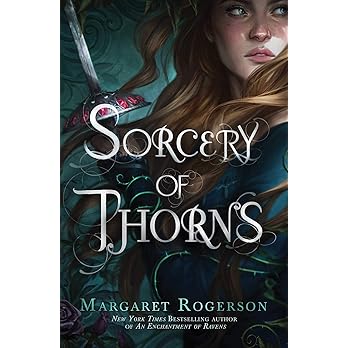
This is squarely in the YA space, and the main mature aspect is a paragraph-long kiss that isn’t, technically, sex but is clearly ramping up to it. Also: A couple less intense kisses, plus the standard standing near each other in nightclothes or other forms of not-suitable-for-public clothing. But if that’s okay, this is an intense Gothic story about a young woman raised in a Great Library: one of a half-dozen preserves for dangerous and often gruesome grimoires that not only have minds of their own but can transform into deadly entities called Malifects if damaged. All Elizabeth wants to do is become a warden, one of the librarians who keep the books safe. But that changes when her Library’s Director is killed by a Malifect and Elizabeth is presumed guilty. She pairs up with a handsome sorcerer and the demon bonded to him – who provides the channel of magic – to discover a conspiracy deep at the heart of the entire land. This leads to an epic, nerve-wracking showdown. It’s a fast read, and Elizabeth is courageous and determined with a strong moral compass.
The Ministry of Unladylike Activity, Robin Stevens

How lovely to be back in Robin Stevens’ universe of great middle-grade characters solving meaty problems (see Murder is Bad Manners below). She was clearly passing the baton to Hazel Wong’s sister May by the end of the previous series, but May is just one of a trio of protagonists in this new mystery set in World War II England. When May figures out her big sister Hazel is going to a secret meeting for something called The Ministry of Unladylike Activity, she bluffs her way to the door, where she meets Eric, and the two take the initiative to track down a spy selling secrets from a remote house in England. There they meet Nuala, a girl their age who is the dreamy counterpoint to May’s bullheadedness, while Eric sits as the practical middle character. All three are outsiders in their way – May is Chinese, Eric is a German expatriate, and Nuala is Irish-English in Britain – and each brings skills to the table to solve the two mysteries that happen in the book. Characters from the previos series will have cameos in this series (Daiy Wells is just … so … Daisy Wells, even as a minor role), but this first book sets the stage for the newcomers to shine.
Arc of a Scythe Series, Neal Shusterman

This is a YA series but, aside from some innuendo and the occasional phrase such as “better than sex,” the main YA aspect is violent – though not usually gory or graphic – deaths. Which is surprising, given that the series takes place in a distant future where people are immortal thanks to healing nanites in the bloodstream and a near-omniscient AI ruler – so much so that “splatting,” or jumping off of buildings to get “deadish,” is a widespread subculture. But to combat population growth, the AI entity known as the Thunderhead created a revered order known as the scythes who are placed outside the law and tasked with doling out permanent death to the people on the planet. When Citra and Rowan become apprentice scythes, they discover a group sharply divided about the policies that constrain them, with a “new order” that embraces the world’s worship and kills for the pleasure of it pitted against the old order that respects the traditions and treats killing as a devout practice. The two are put into a political landscape that pits them against each other even as they develop feelings for each other. The first two books keep tension on a razor edge that keeps you reading, while the third book drags a bit as it spends its time getting all the characters in position for an anticlimactic ending. Nonetheless, my daughter loved this series and couldn’t put it down. The more mature reader may find a lot to mull as the book explores religion, what death gives to humanity, whether a life that’s comfortable is satisfying, and more. And while the villain is clearly a villain, he also makes the occasional good point as the best villains do.
Treasure Island, Robert Louis Stevenson

If your child is into pirates, this classic novel should be a no-brainer. Much of the lore we associate with pirates – treasure maps, deserted isles, talking parrots, and, indirectly, how they talk – come from this book. But even for mild pirate enthusiasts, this is a great adventure story in which a teenage boy named Jim Hawkins finds himself in possession of a treasure map and on the run from murderous pirates eager to get their hands on Captain Flint’s famous gold stash. There are fight scenes, betrayals, treasure, and seafaring aplenty. For such an old book, there’s not a lot of offensive ground – there is reference to Long John Silver’s Negress wife and Jim’s mom is the only woman in the actual book.
His Dark Materials series, Philip Pullman

This classic series is perhaps best known for its first book, The Golden Compass, in which tweenage Lyra Bellacqua sets off with her daemon – an analog to a person’s soul that takes the shape of a talking animal – on an adventure to rescue her friend Roger in a parallel world to our own as she becomes a teenager and discovers love. But the trilogy touches heavily on authoritarianism, represented by the all-powerful Magisterium, a fanatically religious organization. If you’re religious, note that another theme is Lord Asriel’s attempt to give humans free will to take down The Authority, an angel who has set himself up as something like God. So … religion doesn’t come off super well in this book. It’s not openly mocked, but the main battle is about destroying the destructive effects of religion across a wide range of worlds, including our own. The first book doesn’t really dig too deep into that, though, and is the easiest read. By the time Asriel launches his war against the angels in book three, it becomes a bit heavy on theology – my daughter loved the first two books but didn’t make it through the third. Adult readers may find the ending anticlimactic. Note that there is a meh movie adaptation of the first book and an excellent HBO adaptation of all three books.
The Evolution of Calpurnia Tate, Jacqueline Kelly

Set in 1899 Texas, this book is a rich, evocative story detailing the life of Calpurnia Tate, the sole girl in a family of boys. While her mother has strong opinions about what girls should and should not be doing, her cantankerous grandfather is simply pleased that someone in the family is interested in his amateur-scientist investigations. Calpurnia is a fleshed-out character and her brothers are a wide range of types. I loved this book when I first read it, as did my daughter who read it (and its sequel) recently. There is some light mention of house slaves versus field slaves, and their domestic servant is a quadroon, which might warrant some explanation.
Little Women, Louisa May Alcott

This American classic, written in the late 1860’s, tells the story of the four March sisters – Meg, Jo, Beth, and Amy – and their growth from girls to wonen. While it can work for younger readers – we did it as a read-aloud when our daughter was nine – there are a lot of idioms and unusual vocabulary that might be hard enough for adult readers. There were certainly plenty of words and allusions I didn’t know. But aside from a whole heap of moralizing and mid-1800’s views on the differences between men and women, the content is totally age-appropriate for just about everyone. However, if your reader is more sensitive, do remember that Beth dies near the book’s end and is very sick somewhere in the middle. That may be harder for the grownups than the kids, though. Jo is always everyone’s favorite, and is a great literary heroine determined to make her way through a world she doesn’t quite fit into by the strength of her own will and talents.
Fablehaven series, Brandon Mull

When Kendra and Seth Sorenson visit their reclusive grandparents, they learn that the remote property is actually a preserve for magical creatures and that they are the latest in a long line of keepers of these preserves. Thus begins a thrilling five-book series in which the two are at the center of an increasingly desperate race to stop another secret society from opening the demon prison Zzyzx. A friend recommended it to me because of its world-building, and it’s easy to see why. Even over the course of five hefty books, as Mull keeps adding more and more detail to the world and imagining increasingly fantastic environments, the books hold together very well. And there are plot twists aplenty that will have you second-guessing just about everyone even at the end. That said, it took me a while to find Seth or Kendra likeable. Seth’s impulse control issues cause most of the issues in book 1, and it’s something he struggles with to the very end. Kendra, despite being very courageous by the end of the series, starts as largely a milquetoast who is given superpowers that begin to feel Sophie Foster-esque (see Keeper of the Lost Cities, below). There’s also a fair amount of sexism sent her way, some overt, but some just in the way that everyone works to defend her instead of helping her get the skills to defend herself. Still, by the end of the series, I was eagerly waiting to see how the whole adventure would turn out. But I don’t know if I’ll read the follow-on Dragonwatch series.
Flavia de Luce: The Sweetness at the Bottom of the Pie, Alan Bradley

While this mystery series is marketed to adults – with vocabulary and allusions to match – the protagonist is a chemistry-loving 11-year-old and the first book, at least, doesn’t have any sex or serious swearing. There are, however, some very intense parts around the end of the book that might be too scary for young readers. As a mystery, this first book is solid fare, with a mysterious man dying in the garden of the ramshackle de Luce estate and Flavia’s father seeming to be the obvious suspect. Flavia puts her determination and science knowledge to work to solve the mystery. There’s a big exposition blob in the middle that drags on a bit, but overall this is an enjoyable start to a series
The Lock-Eater, Zack Loran Clark

Melanie Gate, an orphan, has always had the ability to open locks. Any lock. She just asks it to open and it does. One night a “gearling,” the mechanical servants of the thaumaturgy that is one branch of the empire she lives in, shows up at the orphanage and asks Melanie to accompany him. Thus begins an adventure wherein Melanie pretends to be a famous magician, runs from cruel archmages, and eventually finds herself facing the terrifying Hexe of the South, who’s been engaged in a war with the empire’s wizards. But Melanie finds out that the easy truths she’s always believed – including the ones about herself – are not the full story, and the gearling is unusual in its own way. This solid adventure will immerse you in its world and leave you hoping there are more books to come.
The Lunar Chronicles, Marissa Meyer
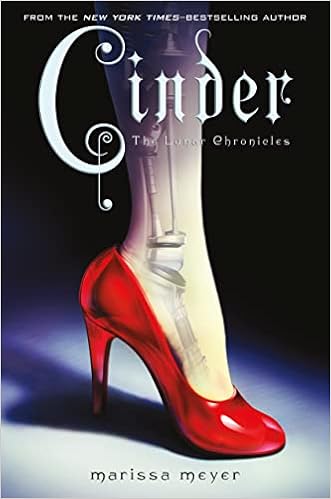
I found this fast-moving, engaging series on a list of “YA books for tweens who are strong readers,” and I really think that “tween” is probably the better lower end of this in terms of content. Though there’s no explicit sex, there’s a lot of innuendo that progresses with the series. The first book, Cinder, is deceptively light on “things that may prompt awkward questions.” And the series develops more intense violence as it progresses. All that said, this is a very enjoyable sci-fi series with cyborgs, interplanetary politics, lost royalty, pandemics, and more. Each book is loosely based on a single fairy tale – Cinder is inspired by Cinderella – but the whole series is an epic, page-turning tale.
The Last Windwitch, Jennifer Adam

Brida, the female protagonist of this book, is chafing a bit at Mother Magdi’s (a hedgewitch) restrictions. No listening to stories told in town, caution about how she uses her magic, and a certain amount of being sheltered. But she soon learns that the stories she loves are true when she scries a mysterious woman in a bowl of water and sees the legendary storm horses running through the wilds near her house. She then finds herself captured by the Queen’s Huntsman who is trying to trap those horses to give the Queen even more magical power. Brida is determined to free the magical horses, and her quest will lead her to make new allies, learn about her true parents, and confront Queen Moira and her sorcerous magic. There’s a big blob of exposition in this that I feel could have been handled more deftly, especially because some of the twists that show up in it aren’t really big surprises, but otherwise this story moves quickly through Adam’s imaginative world and builds to an intense climax and epic battle that you won’t be able to stop reading.
The Ogress and the Orphans, Kelly Barnhill
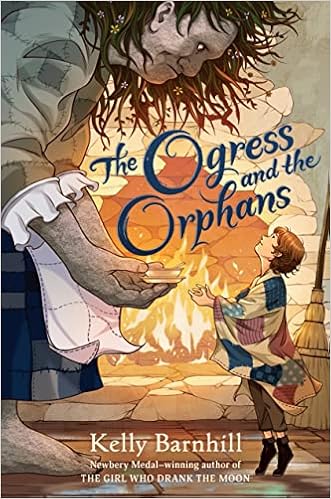
Kelly Barnhill (The Girl Who Drank the Moon, below) is an expert storyteller, and this book doesn’t disappoint. The town of Stone-in-the-Glen used to be lovely. And wonderful. But then the library burned down. And the schools. And people started caring more about themselves then their town and neighbors. Even though a mysterious benefactor – the ogress – leaves bundles of food and other niceties on people’s doors across town. But the town’s mayor – who’s holding his own secrets – convinces the town that the ogress is the cause of their woes. It’s up to the orphans to convince the townspeople otherwise. There are obvious parallels to modern American society: divisiveness vs community, flashy demagogues who hoard wealth and increase divisions in order to keep themselves in power, nostalgia for an imagined better time without asking why it was better and what could we do to get back to that, ignorance and its destructive impacts, and so on. But it’s not heavy-handed at all, and can also be read as a fairy tale. Barnhill also plays around with time quite a bit in this story, such that one character, in tune with the stories of the rocks and wood around him, actually tells stories about events that happen later in the book.
The League of Picky Eaters, Stephanie V. W. Lucianovic

As I know the author of this one personally, I’ll review this by summarizing the reaction from my daughter (a picky eater): lots of guffaws and “oh my gosh, this is so funny”s. As you might expect at a school named for “Saint Julia Child” and based in the town of Muffuletta, Eating is a top-level subject at Minerva’s school. And Minerva isn’t very good at it, at least according to the school’s guidelines. Minerva is particular – picky, even – about her food and as a result finds herself in the lowest tier of eating classes. But while there, she learns that the other picky eaters, ostracized by the rest of the school, are better friends to her than her previous friend who’s a gifted eater. This book reminds me of Upside-Down Magic (see below) in that what others perceive as a fault is at least not something to blame the person for and is at most a trait with its own benefits. It certainly gives a sympathetic view of picky eaters and the attitudes they face in our own world, let alone the over-the-top food-focused world Minerva inhabits.
The Troubled Girls of Dragomir Academy, Anne Ursu

If publishers were trying to concoct a book based on my interests, they could do a lot worse than girls fighting an oppressive patriarchy. Everyone knows Marya’s brother Luka is destined to be a sorcerer. At least until a sorcerer shows up to do a test and Luka fails. Marya’s psychologicaly abusive mother blames Marya, who even right away begins to question how that could be. After Luka’s failure, Marya is ordered to an academy, far from home, for “troubled girls.” There she slowly unravels a mystery with deep implications. I saw the main plot twists almost from the beginning, so to me it felt like it took forever to get to the reveal, but my daughter didn’t see it, and, regardless, this is a well-crafted book with a rich world that will have you cheering for the feminist shift at the end.
The School Between Winter and Fairyland, Heather Fawccett
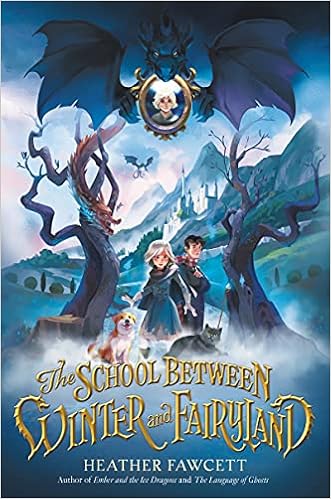
Heather Fawcett excels at interesting stories set in compelling worlds, and this book is no exception. Autumn Malog is a beastmaster at a prestigious magic school. She and her family are in charge of handling the various magical animals being kept at the school, and communicate with them using The Speech. Whenever she gets a break from her duties, however, she tries to find clues about her missing twin Winter. She knows in her heart that he’s still alive; she can sense him. And then one day she sees him instead of herself as a reflection in a castle window. She makes an alliance with Cai Morrigan, the boy fated to destroy the menacing Hollow Dragon who lives in the forest that comes up to the castle. The two of them strive to figure out where Winter has gone while Cai struggles with what the prophecy means for him. The book builds to a momentous conclusion, full of a few twists and turns, as Autumn and Cai unravel the castle’s secrets.
The Secret of Black Hollow Lane, Julia Nobel
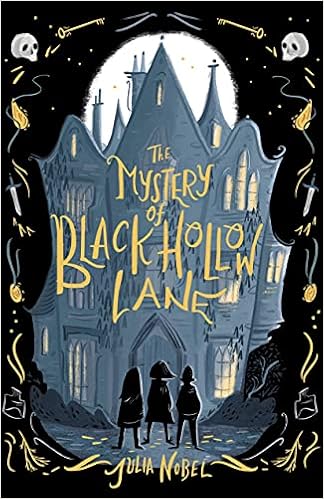
When Emmy is sent off to boarding school in Britain, she thinks it’s just the most extreme of her latest boarding-school transfers as her mother – who writes books about effective parenting – tries to find increasingly competitive schools. But when she gets to the school, she learns that her missing dad – who her mother refuses to talk about – actually went there. As she asks more questions, she uncovers a sinister secret society and finds herself in the middle of a conflict between that society and those enemies working to bring it down. Each of the two books in the series has a tense showdown at the end as Emmy faces down forces that would do her harm. Nobel leaves room for a sequel, but still ties up the situation in two books.
Aggie Morton, Mystery Queen: The Body Under the Piano, Marthe Jocelyn
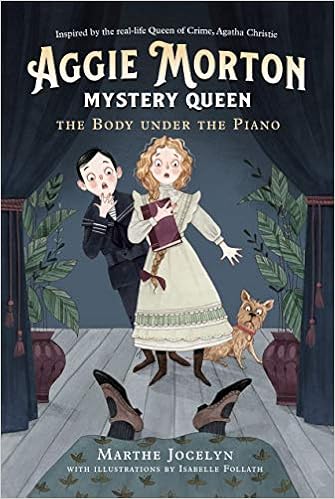
I loved the writing in this mystery novel almost from the first page. In this first book in a series, Jocelyn imagines what Agatha Christie might have been like as a child. A child with an interest in crime who imagines evocative prose she might write when confronted with new situations. When Aggie is the first to find her dance teacher’s sister dead under the piano, she and her new friend Hector Perot set out to figure out what’s going on. Bumbling police, red herrings, sudden twists, and a tense climax make this a perfectly enjoyable mystery, and we look forward to the others.
The Mystery of the Clockwork Sparrow, Katherine Woodfine
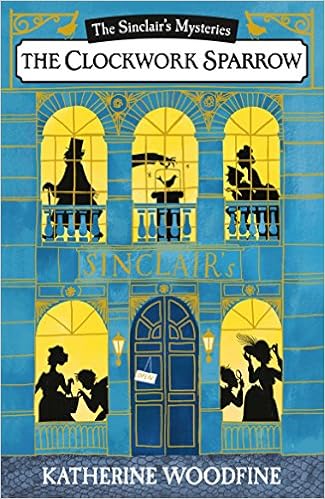
This British import – the first in the Sinclair’s Mysteries series – is a mystery but also an adventure story, as the climax draws near and tension grows. When the book starts, Sophie Taylor, born into money but now poor thanks to some bad choices by her deceased father, has taken a job at the exciting Sinclair’s Department Store. When an amazing clockwork sparrow is stolen from the store’s upper-floor exhibition hall before the grand opening, Sophie becomes the prime suspect. She and an ensemble cast work together to unravel the mystery, which involves one of the most notorious crime lords in London, state secrets being sold to the Germans, and a tremendous explosion. Woodfine ratches up the tension chapter by chapter until you can’t put the book down.
Etiquette and Espionage, Gail Carriger
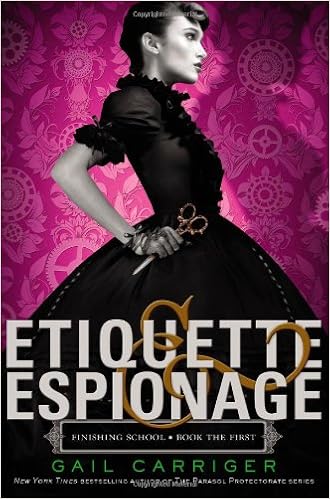
To be clear, this is a YA book. However, the only items that perhaps aren’t appropriate for subtween are references to “ladies of the night” and one scene of innuendo that will be blatant to adults but probably missed by most kids. It’s worth reading in advance if you’re concerned. Beyond that, however, this is a fun adventure set in a steampunk United Kingdom whose population includes vampires and werewolves. When Sophronia is “recruited” to go to a finishing school, her parents hope that she’ll be properly trained in ladylike comportment. And while that is part of the focus, the school, a large ship held aloft by giant balloons, also teaches its students how to spy, pass intelligence, and fight. All in very ladylike ways, of course. Sophronia has some strong natural talents in this regard, and her irrepresible nature causes her to learn more about the ship and school than most of her fellow students while also making allies beyond the student body. There is one character of color, and his Blackness is occasionally commented on, but he and Sophronia become certainly friends with maybe a bit more in the wings. Evidently, innuendo gets a bit stronger in later books in the Finishing School series, so make sure you’re prepared for questions.
City Spies series, James Ponti

See if this sounds familiar. A secretive organization (in this case MI6) has assembled unusually talented children (usually orphans not bound to pesky familial ties) from around the world to do some version of saving the world. It’s a common trope in middle grade fiction (just on this page, see Mysterious Benedict Society, Max Einstein, Nikki Tesla and probably some others). And while I generally now find them grating – the children are too cartoonish in their abilities – City Spies is a great reminder that you can make the trope work with deft writing, relatable characters, and solid plotting. The City Spies are a group of kids recruited from various cities – which then become their secret identities – who possess skills that make them natural spies. Brooklyn, the Latina protagonist of the first book and a newcomer to the group, is a remarkable computer hacker with an intuitive sense of spycraft. Sidney is a great field operative. Kat (short for Kathmandu) is a notably neurodiverse expert at seeing patterns in the world around her. You get the idea. The kids are sent on a mission to defeat Umbra, an equally shadowy organization with the standard villainous goals of world domination and wealth. The way the kids peel apart observations around them that remind me of Sherlock Holmes or Ffolkes, and the plot builds nicely to its conclusion.
Merci Suarez Changes Gears, Meg Medina

In this middle-grade coming-of-age book, Medina hits all the notes you’d expect: friend groups changing, shifting interests, schools shifting from elementary-grade structure to middle-grade structure, and family conflict. But Media is a gifted writer and Latina protagonist Merci Suárez is a fleshed-out, believable, and relatable character. Merci, whose family is maybe lower middle-class, is a scholarship kid at a prestigious school, like her super-smart brother before her. She feels disconnected from her classmates, who live in fancy houses while her own family lives in a clump of houses they call Las Casitas, especially Edna, her grade’s queen bee girl. While the two got along well enough the previous year, now they seem to be butting heads for reasons Merci doesn’t really understand. On top of that, her beloved grandfather is showing more overt signs of Alzheimer’s Disease. Merci makes mistakes, has successes and failures, and overall does her best to navigate a world that’s stacked against her.
Atlantis: The Accidental Invasion, Gregory Mone

Lewis’ dad, once a famous researcher, has been laughed out of his professorship now that he believes that not only is Atlantis real but that it’s responsible for the massive tsunamis that have caused everyone to flee the coasts in this near-future world of noisy hovercars and elevated sea levels. When Lewis accidentally ends up on the submarine built by his dad’s assistant Hannah, the three of them find themselves in Atlantis, where they meet Kaya. Kaya has always believed the stories about the “People of the Sun,” but a grim group of enforcers called Erasers make that a dangerous belief. The Erasers are determined to keep information about the surface away from the Atlantis residents. Kaya works to protect Lewis et al and return them to their home, while the Erasers are trying to prevent the exact same thing. Mone does a good job of constructing a believable Atlantean civilization, but things never feel very tense and there are odd changes in tone when this adventure is interrupted by Lewis burping or doing the chicken dance. It feels as if the editors said, “hey, add some kid humor in here somewhere,” and so Mone grafted on bits of inanity. This is evidently setting up for a series, so perhaps things will get more fast-paced once the character development and world-building are out of the way.
The Boggart, Susan Cooper
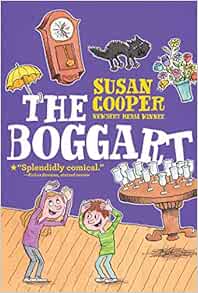
When the Volnik family learns they’ve inherited an old Scottish castle, the kids are super excited. But when they go to vist, they realize it’s run down and agree to sell it, collecting a few of the items in the castle for themselves. Inside one of those items – a desk with a locking top – slumbers a mischief-making Boggart who has lived in the castle for time immemorial. Unleashed in in their home town of Toronto, he runs wild in the modern world of electricity and computers, but as the kids realize what’s happening, they also begin to realize that the Boggart longs to return home to the castle he had adopted. While the cover of this book mentions how humorous it is – and certainly my daughter laughed at the Boggart’s antics – I was more struck by the vivid descriptions of the Scottish countryside and Cooper’s portrayal of the Boggart’s great sorrow and longing, which continues in the sequels.
Fearless, Mandy Gonzalez
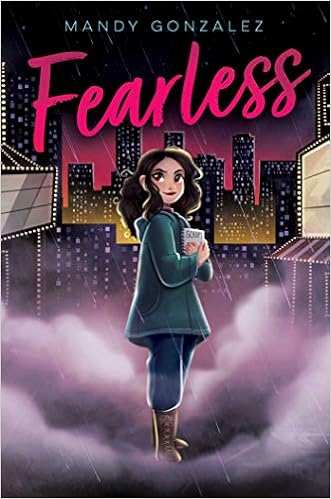
When Monica Garcia gets a call to be in a Broadway show, she discovers that she’s the understudy to the understudy for one of the leads. But then she discovers that the lead has bailed and the first understudy has been injured, so she’s suddenly in the lead role. But the whole cast and theater community believes that the Ethel Merman Theater is cursed. When she is mysteriously given a secret key and also words of encouragement by doormen around the community, she and the other child leads set out to break the curse. Gonzalez is herself a Broadway star, with roles such as Angelica Schuyler and Elpheba under her belt, so she gives a backstage peek at Broadway traditions, superstitions, and lore (though her interpretation of where “break a leg” comes from is listed as popular but implausible on Wikipedia). I found the ending a bit unsatisfying: The curse seems to have a magical realism element, but then the whole mystery of solving it seems to be set up deliberately by the producer and an old owner of the theater, making one wonder if it was just a promotion campaign. But if your child likes theater, they may like this intimate look at a production.
DaVinci’s Cat, Catherine Gilbert Murdock
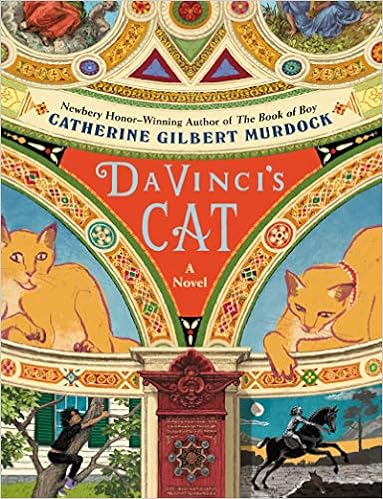
In this time-travel adventure, Federico, heir to the Duke of Mantua and hostage of the pope in 1511 Rome, stumbled across a kitten who emerges from a precious cabinet sent to the pope as a present. The kitten disappears back into the chest, and when it emerges again, it’s a full grown cat. Visitors from 1920s America and present-day come through and meet him, Raphael, and Michelangelo in a story of Doctor Who-esque twists and jumps in time, all centered around the cat known as Juno.
The Time of Green Magic, Hilary McKay

In this magical realism book, Abi, Max, and Louis are trying to adjust to life in their new, blended family. When they have to find a new home, they find an empty, ivy-colored house that comes with a particular magic – you can find yourself literally transported to a location within a book, and things within books can escape. The three kids each experience this in their own way, until they ultimately have to work together to put a prehistoric large cat back into the book it came from. The book has beautiful turns of phrase and evocative imagery that allow the surreal, dreamy atmosphere to come alive.
Daughter of the Deep, Rick Riordan
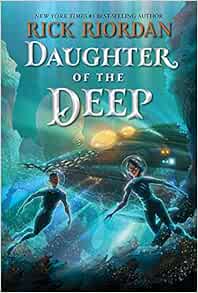
Rick Riordan takes a break from writing about the descendants of Greek gods to write about the descendants of Captain Nemo in this complex adventure. Ana Dakkar, an Indian-American girl who is the latest descendant of Captain Nemo, is setting out on a class field trip when her school, the marine-science-focused Harding-Pencroft Academy, is destroyed by missiles fired by an offshore submarine. The field trip suddenly becomes a race to find and safeguard Captain Nemo’s hidden base (from The Mysterious Island) and the amazing technology he developed before the Land Institute students take it by force. The book is steeped with love for Jules Verne’s stories and an appreciation for the deep sea. While the book is a solid adventure that my daughter and I both liked, I was struck by the fact that Ana suffers from severe menstrual camps (and like many other women, has to still go about her daily life). This perfectly normal occurrence is so often left out of stories featuring girl characters – I can think of more books that talk about characters relieving themselves – even though it’s a reality for girl readers in the target audience.
The Girl Who Stole an Elephant, Nizrana Farook
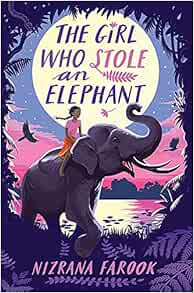
In this fast-paced, slim story set in maybe pre-Industrial Sri Lanka, Chaya is a practiced thief who, Robin-Hood-style, steals from the wealthy merchants to provide money for villagers in need. When her most recent heist goes wrong, her best friend gets blamed – no one believes it could be a girl who did the stealing – and she, along with a wealthy Muslim girl, breaks him free and escapes on the titular elephant. The three do their best to elude the King’s guards until they eventually fall in with the King’s half-brother who’s trying to claim the throne as rightfully theirs – only to discover that the King’s half-brother is actually his half-sister.
The Mysterious Benedict Society, Trenton Lee Stewart
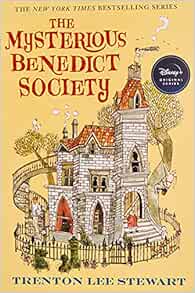
This is a popular series, but it didn’t particularly resonate with me. Maybe I’m just tired of what a friend calls “C students imagining what A students are like” types of books, in which the intelligence on display isn’t at all realistic. Mr. Benedict recruits super-intelligent orphan children via a newspaper ad to uncover the nefarious brain manipulation coming from a nearby island and led by, it turns out, his previously-unknown identical twin brother. The four children have to work together as a team to navigate increasingly implausible situations, and the end is reasonably paced enough, even if the rest of the book feels like a slow ramp up.
Keeper of the Lost Cities, Shannon Messenger
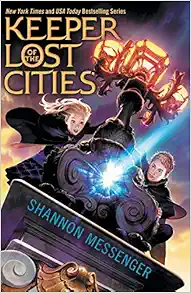
My daughter loved this series so much she went as Sophie Foster – the 12-year-old Caucasian protagonist – one year for Halloween. Given how long it takes to get these books from the library and how many other kids love the series despite their door-stopper size, she’s not alone. Foster is a bit of a superman figure, genetically engineered to have incredible abilities. When she learns she isn’t a human as she’s always thought but an elf, she learns that her skills at telepathy are rare among elves and she’s the most powerful one anyone’s ever met. Likewise her photographic memory, her knowledge of things she’d have no way to know being raised by humans, and various other things that happen to her. The first book has her trying to navigate her new home and fluttery feelings about boys in her magical school even as she learns she’s somehow connected to the mysterious Black Swan Society. The other books build on the mysterious world that exists in parallel with our own and reveal that the seeming utopia of the Lost Cities is, like many utopias, a harsh reality for those not in the privileged set. Adult readers may tire of Sophie’s seemingly infinite super powers and tweenage moodiness, grimace at the seeming lack of editorial oversight in later books, and find themselves wondering about the world (“If elves are immortal, why are there so many kids around Sophie’s age?” “If every elf is given more money than they would ever need, why do the use money at all?”), but the books are nonetheless page-turners that will keep anyone reading and eagerly going to the next one. Note that the series gets much darker towards the end and that there is lots of (largely and maybe exclusively heterosexual) tweenage crushing: blushing, heart flutters, jealousy, love triangles, and speculating on who likes who, even when the group is in some dire, deadly situation..
Thrones and Bones series, Lou Anders

My daughter and I both really enjoyed this fun, high-fantasy nonstop adventure series. Karn, from his world’s Scandinavia-esque Northern regions, is a preternatural strategist who loves board games. When he awakens an old undead king, he finds himself on the run from the king’s minions. Thianna, a strong, fast half-human/half-giant girl who’s had to survive the bullying of brutal giants who think she doesn’t belong, has to leave her village when her human mother’s old pursuers come looking for her. The two kids team up and become fast friends in the process. The first book is mostly self-contained, with the other two books continuing their adventures that ultimately end up transforming the world’s politics in significant ways. By the third book, the constant escapes begin to be a bit tiring, but Anders builds a convincing world inspired by older European cultures (as far as can be determined, everyone in the book is Caucasian) and brings the series to an epic close. The books (and the author’s website) contain instructions for the games created for the books.
Ancestor Approved, Cynthia Leitich Smith

All the short stories in this collection happen within the shared framework of kids at a powwow in Ann Arbor, MI. A number of different Native tribes are represented in the stories, which lightly weave together – the most recurring theme is a dog wearing funny t-shirts (that dog is the narrator of one of the stories, as well). While my daughter enjoyed the book, I found it hard to get a strong sense of the powwow itself or to really get a sense of each of the kids. To some extent, this is a limitation of the short story medium. They are, by definition, short.
Ember and the Ice Dragons, Heather Fawcett
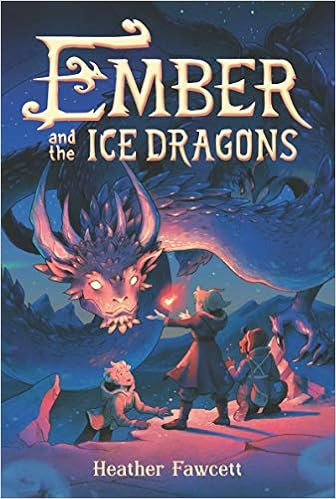
When Lionel St. George finds an orphaned, pitiful fire dragon – a feared beast in Fawcett’s alternate universe’s Victorian Age – he is moved to save it. To keep her safe, he transforms her into a human girl. All except her wings, which he renders invisible. Twelve years later, she’s having trouble controlling her flame, so she journeys to her aunt in Antarctica. There she learns of the Winterglass Hunt, a hunt dedicated to killing ice dragons. Ember and her friends Nisha and Moss decide to sabotage the hunt but ultimately have to then rescue the Prince in charge of the hunt after he’s kidnapped by ice dragons. Fawcett weaves a complicated world with rich characters, and my daughter and I both enjoyed this book quite a bit. Sensitive readers might balk at the descriptions of suffering dragons, but it’s not too graphic, and the book ends on a hopeful note about the future of dragonkind.
The Maypop Kidnapping, C. M. Surrisi

When Quinnie Boyd’s tutor doesn’t show up to start her school year, Quinnie becomes increasingly convinced that something nefarious has happened, and she sets out to investigate. In many ways, this book shows how not to investigate properly. Quinnie comes up with suspects on scant evidence and then works to find evidence that supports her theory. Her mom – the small Maine town’s mayor, sheriff, postal carrier, and real estate broker – tries to steer her to looking at the facts as they are, but it’s obviously hard for Quinnie to do that, and her impulses drag down portions of the book as the reader wonders what on earth she’s doing. Still, her hunches do end up saving the day, freeing Ms. Stillford from a not-actually-quite-a-kidnapping and stopping some thugs. The text will really make you think there’s a grow house deal gone awry, but it’s a bit more, well, young-person friendly. My daughter enjoyed this and its sequel.
The Gilded Girl, Alyssa Colman
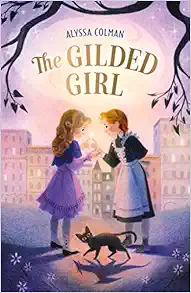
In the magic-infused parallel world of The Gilded Girl, Emma is the daughter of a wealthy “magitect” being sent to a finishing school to harness her magic properly. Though virtually everyone gets access to magic at an early age, it is a crime for anyone not wealthy enough to “kindle” their magic past their 12th birthday. Servants are expected to snuff their magic. As far as Emma has ever known, this is for the good of everyone. But when her father is presumed dead in the San Francisco Earthquake, her funds are gone and the cruel headmistress demands she work as a servant in the school where she had been a student. And she expects Emma to snuff her magic just like other servants. But Emma meets Izzy, the other servant girl, who is determined to somehow kindle her magic. And as Emma learns in her new hard-knocks life, Izzy isn’t alone. The poor of the city resent the harsh laws that favor the wealthy and prevent the poor from ever rising above their station – the best jobs all require magic. It’s not hard to read allegories of our own world’s privilege and classism into this book, and you’ll be cheering with Emma and Izzy – and their friends, including a house dragon that looks like a cat – as they fight to free every magic user.
Winterling, Sarah Prineas
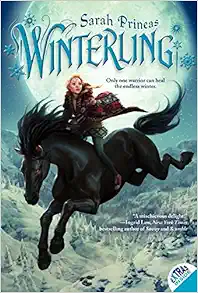
When Fer notices a boy being attacked by wolves and a pond reflecting a different moon than our own, she learns that she has the power to open a Way, a path between worlds. On the other side, she hopes to learn more about her parents – her human father and her mother from this other, more magical world. She quickly meets the deceitful Mor, who almost convinces Fer to ally herself with her rule. But Fer, helped somewhat by the boy she rescued, a puck bound by oaths to the Mor, and by other members of the Mor’s court, discovers that she is the rightful Lady of the land, as her mother was before her. It is up to her to defeat the Mor and take her rightful place. As the series progresses, Fer upends the traditional way things have been done and causes much consternation with the other Ladies and Lords, but always motivated by the urge to do right as she sees it. While the series uses darker Faerie mythology, it never gets too scary, and Fer is easy to root for.
Isle of the Lost, Melissa de la Cruz

If your child has been sucked into the maw of mania for Disney’s The Descendants, they may be happy to know these books exist. The books, of which I’ve only read the first, intertwine throughout the movies – the first one is a prequel to the first movie, and the fourth comes before the third. This first book discusses how the VK become friends, though it’s hard to imagine Mal and Evie’s friendship is as deep as it seems in the movies based on this book, where their friendship only starts towards the end, shortly before the movie’s beginning. (In an appropriate twist, however, the standard middle-grade drama of making new friends is turned around as we get Mal’s point of view as someone explicitly setting up Evie to hate her new school.) de la Cruz is a capable enough writer, but the Descendants universe is clunky in many ways. Every single person has to be tied to Disney movies somehow, which makes for some awkward shoehorning. There’s a bit of body shaming here and there, and the book only digs a bit deeper into the fact that the Auradon setup is a rigid caste society that’s unfair to everyone except the royal class. Ben begins to realize this and make amends, which of course is what leads to the plot of the first movie.
Lola Benko, Treasure Hunter, Beth McMullen
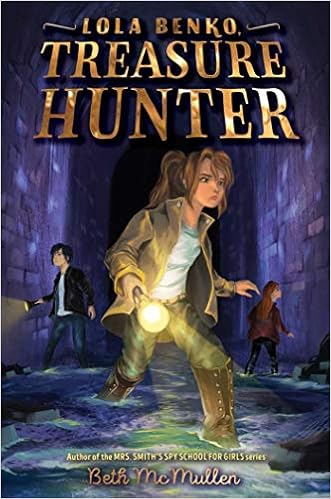
Adults won’t even need to get to the Acknowledgements before recognizing that this is essentially an Indiana Jones movie with a middle-grade girl protagonist. Lola Benko, the Caucasian daughter of a famous archaeologist, is not convinced that he died like everyone says. Realizing she’ll need money to travel to Europe and bribe people, she starts trying a life of crime, which only gets her into trouble and lands her one final shot to redeem herself at an academically rigorous San Francisco private school, thanks to a mysterious benefactor who’s a tech mogul. There she teams up with, and eventually befriends, Jin, an Asian boy, and Hannah, another Caucasian girl. The three set out to find a famous treasure that they can use to get her dad back. If you liked the smart-alecky first-person narrator of McMullen’s Mrs. Smith’s Spy School for Girls series (see below), Lola Benko will feel familiar.
The Story Collector, Kristin O’Donnell Tubb
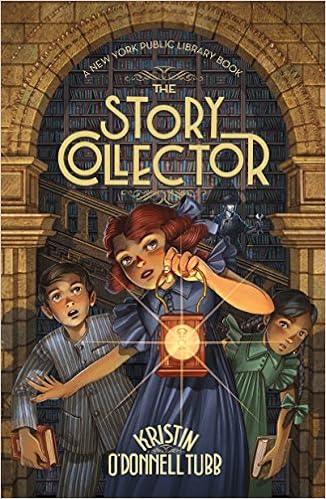
My daughter liked this story well enough, but I felt that it dragged on a bit, perhaps because I was expecting a mystery that doesn’t actually start in earnest until near the end of the book. Still, it’s not hard to daydream about living Viviani’s life as the daughter of the live-in superintendent of the main branch of the New York Public Library. Based on a real family, this book sees Viviani struggling to impress a new girl in class by stretching her customary stories further into the lie and trickery category. Along the way, a valuable stamp collection gets stolen, and it’s up to Viviani and her friends to figure out what happened.
Premeditated Myrtle, Elizabeth C. Bunce

Start with one precocious Caucasian upper-middle-class girl obsessed with criminology. Add in her supportive, stoic, and largely unflappable mixed-race governess. Combine with suspicious shenanigans next door in Edwardian England. The result is a fun, engaging murder mystery peppered with red herrings and surprising twists (and, as my daughter notes, a good start because the murder happens right away). Myrtle is an inpsiring character, celebrated for being smart even as her widower father tries halfheartedly to teach her how a proper lady should behave. The first in what is so far a trilogy, we look forward to reading more of her adventures.
The Sisters Grimm, Michael Buckley
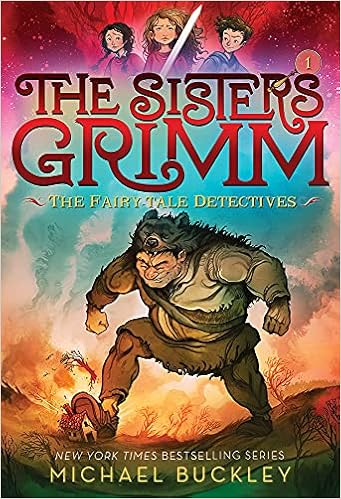
My daughter likes mysteries. She also likes fantasies. So a mystery series set in a fantasy universe? Solid gold. The fantasy universe is actually a small town in New York and its denizens are the middle-grade-novel-ubiquitous fairy tale characters of all the classic Western books and stories you’ve ever read or heard of. When Caucasian orphans Sabrina and Daphne are reunited with a grandmother they were told was dead, older sister Sabrina is at first skeptical of the woman’s claims that she and the girls are descendants of the Grimm brothers, now tasked with keeping all the “historical figures” from their stories (and those of Carroll, Baum, and the rest of the bunch) bound to a small geography where they can’t do harm to the general population. This makes the Grimm family … not exactly popular in the town. When the girls’ grandmother and her associate Mr. Canis are abducted by a giant, it’s up to the girls to solve the mystery of how the giant got there and rescue their newfound family. The mystery at the center takes a few twists that are gettable before the reveal. The whole series of nine books goes beyond mysteries and into a large-scale war.
The Last Fallen Star, Graci Kim

Another of the Rick Riordan Presents books, this one focuses on Korean mythology. Riley has been adopted into one of the many magical Korean families in Southern California and longs to have magic like those around her. As she and her sister, Hattie, concoct a plan to give Riley magical powers, they learn about Riley’s birth family and Hattie’s life is put in grave danger. Riley, determined to save her sister, sets out on a god-given quest to find a powerful weapon the god wants to remove from our Mortalrealm. Throughout the quest, Riley finds exiled witches, learns more about herself, interacts with mythical beings and creatures, and begins to suspect many of the truths she’s been told. The story takes a few twists that you might suspect coming, but Kim keeps new information coming as the story reaches its conclusion. The book clearly sets up for sequels.
The London Eye Mystery, Siobhan Dowd

It seems simple enough. You send your cousin off on the London Eye. You watch him get into the cab. You track the cab all the way around. And then he gets out at the bottom. But what if he doesn’t? That’s the mystery Kate and Tom (the narrator, who has high-functioning autism) face, as their family and Salim’s mom are increasingly distraught with worry. My daughter saw the crucial clue early on, but I missed it. And even when they solve the titular mystery, there is still yet one more mystery to solve before the end. Definitely a good read for mystery fans, and the sequel is written by Robin Stevens of Murder Most Unladylike (see below) fame.
Young Fredle, Cynthia Voigt
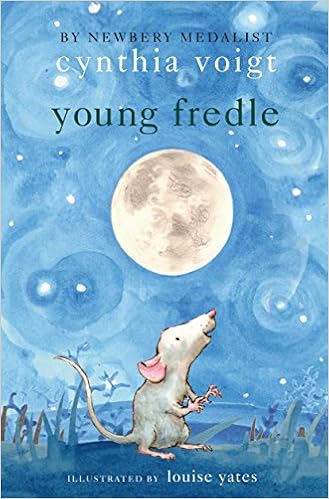
The second, chronologically, of Cynthia Voigt’s “Farm animal” series (see Angus and Sadie, Little Bird, and Toaff’s Way below). In this book, Fredle, a mouse, is pushed out of the nest when he becomes sick. Rather than becoming “went,” as the mice say, he is put outside by Missus and has to make his way. As he meets various animals – helpful and not – outside, he learns about the wide world outside a house mouse’s life. As is typical of these books, his curiosity and skepticism drive a lot of his discussions with animals, and he builds a new world view derived from an experience that ends up being wider than that of any group he encounters. A friend of mine considers this his favorite of the series. Like Angus and Sadie, the proportion of text to pictures would probably more put this in my chapter books list, but it’s here for consistency with the rest of the series.
The Triumphant Tale of Pippa North, Temre Beltz
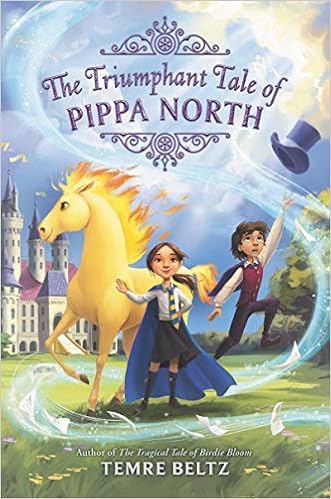
This book is set in the same world as The Tragical Tale of Birdie Bloom (see below), but is completely non-overlapping (though there is a brief allusion to that book in a footnote in this one). However, it follows a similar format: the book itself is the narrator of an adventure that kicks off when the powerful, prescient, and seemingly whimsical Winds of Waverly deliver correspondence between two unlikely pen pals. Pippa North is chosen to be a Triumphant, the Chancellor-sanctioned roles who always have happy endings. But she’d really much rather stay at home in Ink Hollow. Meanwhile, Oliver is a would-be Magician who has yet to receive the magical hat that marks him as a full member of that society. The two begin journeys that eventually converge as they uncover a Magician plot to bounce the Triumphants – who aren’t really trained or anything because their happy endings are guaranteed – from their home. While the hierarchy of Triumphant selection is hinted at in Birdie Bloom, it’s made more explicit here: Certain families are effectively preselected to be Triumphants regardless of skill or temperament. As Pippa tries to return to her former life, she eventually becomes the exact kind of Triumphant Wanderly looks to while having the realization that perhaps the Chancellor’s rigid roles aren’t as well thought out as they really should be. This is just as enjoyable and fast-paced as Birdie Bloom, and I hope Beltz releases more in this universe.
The School for Good and Evil, Soman Chainani
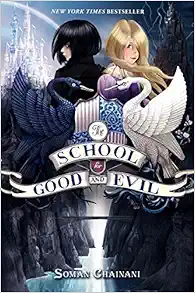
Every four years, the elusive School Master comes to the village of Gavaldon and takes away two kids to be written into fairy tales. One destined for the School of Good, one for the School of Evil. While most of the villagers try and avoid it, Sophie has been longing for it as an escape from her village. She believes she’s destined to be a Good and lives the life she imagines a princess should have. Her friend Agatha, however, looks more the part of an Evil; she dresses drably, lives near a graveyard, has a mangy cat, and is put off by all the Good trappings Sophie aspires to. When the two are abducted for the School, however, Sophie ends up in the School for Evil while Agatha ends up in Good. It’s not particularly challenging to see Sophie as Evil – all her good deeds are performative, she flings insults easily, and she’s fantastically vain. It takes a bit longer to realize that it makes sense for Agatha to be a Good, even if she is tempted by many things on the Evil side (the School and its staff don’t do nuance; when it’s in Good vs Evil mode, everyone on either side is trained to purge thoughts from the other side so they are wholly Good or wholly Evil. when it’s in girls vs boys mode in book 2, the girls side looks like a radical feminist training ground). The two girls struggle to either switch schools or get home, with Agatha going above and beyond to help her friend in the other school, not only in her studies but in her quest to secure the love of the hunky Good boy. This is a pretty dark variant of the ubiquitous “secret lives of fairy tale folks” genre of middle-grade fantasy: residents of Gavaldon see former villagers in the books they read, and students who score poorly become the flora, fauna, and props of fairy tales, and the School Master is a sinister, manipulating figure. There’s a lot of depth to the school and the world, and the plot is exciting, with a big final showdown.
But there are issues. I’m not okay with the body shaming. While the book seems to be making the point that Good and Evil are inside you and not based on how you look, Agatha’s princess-y classmates are described pointedly as pretty, using their thin body shapes to make the case. This equates thin not just with pretty but with Good. Many on the Evil side are fat, and Sophie views “fat” as the deepest insult she can use. In the second book, some of the Good girls are implied to have let themselves go by becoming more plump, rather than returning to a natural body shape once they’re not in service to a misogynist viewpoint. In addition, while this is often held up as a fantasy with strong girls, there is a scene in the first book where Sophie’s schoolmates leave her trapped in a glass coffin with an amorous admirer which these days reads as a sexual assault scenario. Also, Sophie dresses in increasingly slinky and revealing outfits to attract the attention of the Good boys which, while I can’t deny that that would be effective, isn’t a great message for tween readers already dealing with body image issues. There are some queer romance themes amongst the very tweeny crushing, but if you’re looking for strong queer representation, this isn’t it. (There is a movie version of the first book due out in 2022.)
The Hobbit, J. R. R. Tolkien

You’ve probably heard of this one. But while it’s understandably hard to separate from The Lord of the Rings, this book, unlike those books, is intended for children, and the adventure rarely bogs down as Bilbo goes from one key moment to another. It is worth pointing out that this is a big old sausage fest, with not a single girl character, though I remember reading about one dad who made Bilbo a girl when reading it aloud to his daughter. I re-read it recently and thought it works pretty well as a book for modern-day kids, even those unaccustomed to the slower pace of older books, and my daughter enjoyed it. There are, of course, Peter Jackson movies of this book, but they’re pretty ludicrously awful (though I liked his Lord of the Rings adaptation).
Silver Batal and the Water Dragon Races, K. D. Halbrook

I found this book as a “read-alike” for The Twelve (see below), and I’m a bit mystified as to how it had escaped my attention before. Strong girl character, rich fantasy setting, underdog winning a huge victory. It checks a lot of boxes. But I’m happy I did eventually find this fast-paced, tense tale. Silver Batal is an apprentice jeweler in a small desert city but dreams of becoming one of the fabled water dragon racers, who ride large beasts – the endpapers show some of the species – for honor and riches. But her dreams take a turn when she learns her hero is cold and callous. And then she bonds (a mental and emotional bond reminiscent of Anne McAffrey’s Pern books) with an Aquinder, a dragon species thought to be extinct, after its mother is stolen by said racing hero. She travels with the dragon, her cousin, and friends along the way to rescue the older Aquinder, and comes up with a plan to win the dragon’s freedom in the water dragon races she’s always dreamed of. The titular races become more of a means to an end, but the rescue gets increasingly tense and my daughter was eager to read the next one, which hopefully resolves some of the loose ends with Silver’s family. While the story and world are rich, it’s worth noting that Halbrook devotes a reasonable chunk of words to the foods that Batal eats, delicious-sounding Middle Eastern fare that will make you want to go to your closest street-food vendor.
Absolutely Truly, Heather Vogel Frederick

The skeleton of this book is a decades-old scavenger hunt set in small-town New Hampshire, but those bones are carrying a lot of additional story. Truly Lovejoy – a six-foot-tall seventh grader – has just moved, with her seven-strong family, to the small town of Pumpkin Falls, where her father (and his father and so on for a hundred years or more) grew up. She moved from Austin, which was going to be the first permanent home for her military family. The family abandons those plans, though, when her dad loses his arm and best friend to an IED in Afghanistan. He’s clearly dealing with depression, and the family is trying to help him cope. As Truly tries to adjust to this abrupt life change, she finds a note in the family’s bookstore – an on-the-rocks business now helmed by her dad and her peripatetic aunt – that leads her and some of her new schoolmates on a quest through the town’s landmarks and colorful characters. I really liked this book, with its sympathetic but realistic view of small-town life and its well-established central character and the relationships she forms. This book is the first in a trilogy (during which middle-grader Truly seems to go from “so what about boys?” to “omg, boys!”), the rest of which my daughter quite liked (but I didn’t get a chance to read before they went back to the library.)
The Enola Holmes Mysteries, Nancy Springer
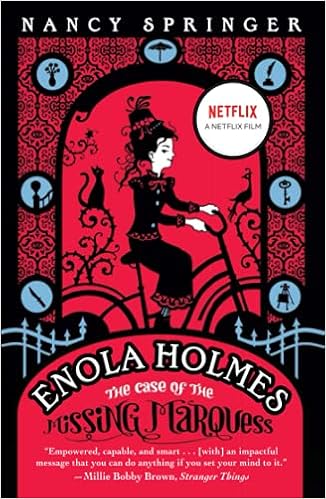
My daughter loves this series, which features the younger (half) sister of Sherlock and Mycroft Holmes setting up her own investigation business to track down her mom who went missing while avoiding the brothers who believe she should be in a finishing school instead. Each story offers disguises, ciphers, clever deduction, healthy dollops of railing against the sexism of the time, and detailed descriptions of women’s clothing. But don’t let the slim books make you think they’re more like Heidi Heckelbeck than, well, Sherlock Holmes stories. The cadence and tone are more reminiscent of Masterpiece Theatre, and your child may end up asking you what “prostitute,” “lady of the night,” and “procuress” mean. There’s also a fair amount of violence: In the first book, Enola is almost garrotted. But there’s no denying that Enola is a great role model for girls: She’s smart (to the surprise of her brothers), astute, and independent. And she uses her knowledge of how women and girls move through the world to figure out things that Sherlock overlooks because he doesn’t bother with women’s things. I particularly like that she explicitly notes the trope of “dressing like a boy to hide” and dismisses it, because that’s what her brothers will assume she did. It’s worth noting that there’s a Neflix movie (with another in development) that has the same spirit as the first book, but embellishes and changes a fair amount. Also note that after a ten-year hiatus, Springer released Enola Holmes and the Black Barouche, which says it’s pitched at the YA age group, but I’m hard-pressed to understand why. Maybe it’s a bit more explicit about using terms like “womanizer,” and maybe the vocabulary is trickier – I had to look up some words – but it doesn’t seem substantially more so than the books aimed at the upper middle grade range.
The Amelia Six, Kristen L. Gray
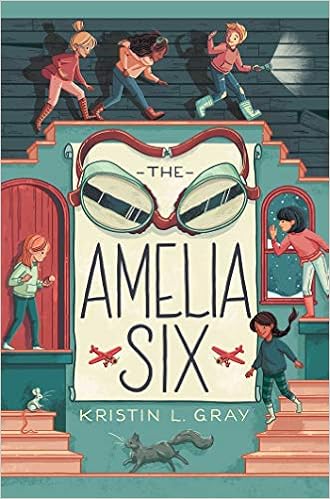
Whatever trivia you currently know about Amelia Earhart, you’re likely to learn more as you read this book. Millie, who is the focal point of the book, is one of six gifted girls chosen from around the country to stay at Amelia Earhart’s birthplace museum (which is a real thing). But while being feted by the museum staff, Amelia Earhart’s favorite pair of goggles goes missing, and suddenly all the girls are involved in a closed circle mystery. Gray does a good job of teasing the readers about the culprit until the very end, and Millie finds friends she wouldn’t have imagined before. The six girls are of various races and family situations – Millie herself is Caucasian living with her single dad.
Sophie Quire and the Last Storyguard, Jonathan Auxier

This book show up often on Mighty Girl lists, and it’s not hard to figure out why. Sophie Quire is a smart, passionate, determined girl (Black or Brown, it seems) who finds herself at the center of a fast-paced adventure of the kind she’s only read about in her beloved books. When we meet her, she’s quietly trying to rescue books from a city-wide book burning. Her deft hand at book mending leads Peter Nimble to bring her a mysterious book called The Book of Who (you need not have read Peter Nimble and His Fantastic Eyes before this one – enough of his back story is provided – though I note my daughter liked it as well). The Book of Who, it turns out, is part of a quartet of magical books that, when combined, can bring powerful magic into the world. Sophie is tasked with finding them all and their Storyguards – she is a Storyguard herself, The Book of Who informs her – so that she can save the world from the book’s Big Bad and hopefully also find out what happened to her mother shortly after Sophie’s birth. I quite liked this book for its fast-moving story, interesting world, and solid writing. I do feel like the Big Bad should have gotten more time to air his motivations – he actually raises some good points about the consequences of powerful magic being brought to bear – but that’s a minor complaint about a thoroughly enjoyable middle-grade read.
Angus & Sadie, Cynthia Voigt
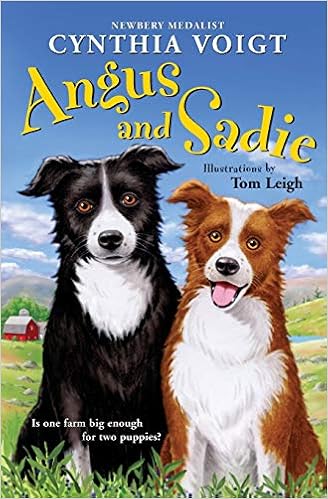
This is the first book in Voigt’s “animals on a Maine farm” books (see Toaff’s Way and Little Bird below) and introduces series regulars Angus & Sadie, the two border collie mixes that live on the farm. It lacks the rich descriptions of background sounds on the farm, but features similar themes of finding your own way, even if – or especially if – it contradicts others’ expectations. When Mister and Missus bring home the two border collie puppies, they expect them to be the same – smart potential sheep herders. But while Angus, a total bro dog, excels at sheepherding, Sadie is a more sensitive soul, prone to chasing butterflies. Angus and others assume she’s afraid of everything, but she learns she’s not really; she just doesn’t care about the same things. This book is slimmer than Toaff’s Way or Little Bird and is a good intro to the farm, though I much prefer the later books I’ve read.
Mystery & Mayhem, Katherine Woodfine (editor)
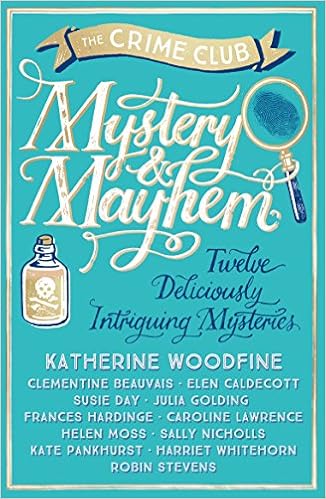
Our daughter became hooked on mysteries after reading the Wells & Wong series (see below), and so she enjoyed this collection of short mysteries. Many involve characters in the authors’ main series (though, sadly, not Robin Stevens’ story, which takes place in a more modern setting than Wells & Wong), so it was also a great way to find other series she might like. The stories here are largely set in England or heavily-influenced-by-England countries, ranging across time periods and featuring a diverse set of boys and girls as the main crime solvers.
The Detective’s Assistant, Kate Hannigan
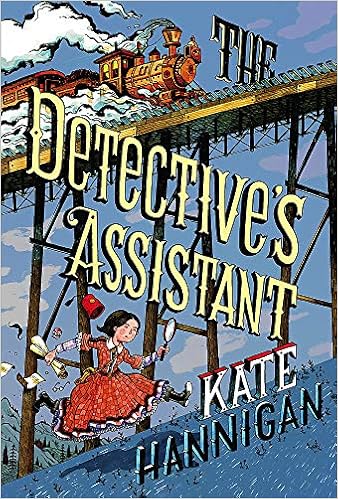
When Nell Warne is brought to her “Aunt Kitty,” the last surviving member of her family, she discovers that her aunt has made a new life as Kate Warne, the real-life first woman hired as a detective by Pinkerton’s. Nell and her aunt have a tense relationship, because Kate believes that Nell’s dad killed her late husband, but Nell begins to carve out a pocket in Kate’s life by assisting her in detective cases (largely drawn from Warne’s historic exploits). A lot of back story comes from correspondence with her friend Jemma, who went to Canada with her family to remain free after slave catchers come to their free state looking to kidnap Black people and bring them South. Hannigan writes enjoyable historical fiction, and Nell is a great character, determined and loyal.
Little Bird, Cynthia Voigt
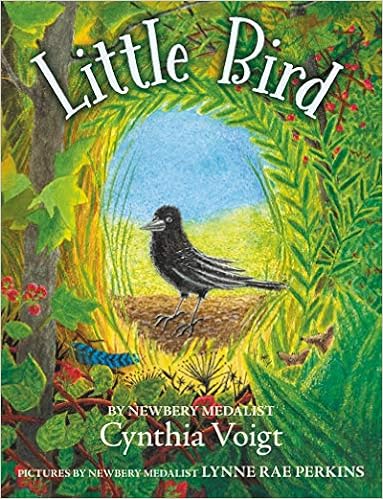
This book about a thoughtful, determined crow is another in Cynthia Voigt’s collection of books focusing on animals on a Maine farm, all of which we’ve really liked so far (see also, Toaff’s Way below; Toaff has a minor but critical role in this book). This book has all the hallmarks of the series: a protagonist who questions the things they’ve always been taught, characterizations of animals that make them seem human while also staying true to what you’d expect from that animal, and a rich aural description that makes the soundscape of the farm come alive. In this book, Little Bird, the smallest in a crow family, sets out to find the fisher who stole Our Luck, a talisman the crows keep that they believe wards off bad things. As Little Bird travels around the farm and beyond, she listens and learns from the animals she encounters, including the humans who tend to her when her wing is injured. Her travels make her realize how big and wonderful (and also scary) the world is, and she grows into an independent bird who’s more sure of herself in the world.
Eva Evergeen: Semi-Magical Witch, Julie Abe

“perfect for fans of Kiki’s Delivery Service” says the blurb. Yes, I imagine so. There are many parallels and the movie, at least – I’ve not read the book – clearly influenced this story. Eva Evergreen is the daughter of the most powerful witch in the kingdom, but she herself only has “a pinch” of magic, and gets tired easily if she does more than a few spells in too short a span of time. Still, she manages to convince the Council that she should be allowed to go on her Novice quest to prove her worth, and she ends up in the seaside town of Auteri. As she settles in, she begins to find how to make the most of her small amount of magic. There’s a nice subtle shift in the book where she stops saying “if I were my mother, I’d just …” and the reader sees her piecing together how to solve problems in a way that makes sense for her without thinking about how other people would solve it. She falls in love with the town where she’s landed and makes strong friendships, and her push to save her new home from a particularly violent storm will have you cheering (and, weeping, if you’re as prone to it as I). I saw the last-page twist coming right away, but it sets up nicely for an action-packed sequel.
Midsummer’s Mayhem, Rajani LaRocca

This book will magically transport you to that far off time in your life when you brought picnic lunches to Shakespeare in the Park or huddled under blankets at an outdoor theater while the fog crept around you. You remember, right? Before you had kids? Even those who aren’t familiar with the story of A Midsummer Night’s Dream will see a lot of the parallels by the end, and those who do know the story will see connections almost immediately. But ultimately this is a story that touches on common middle-grade themes of navigating confusing changes in one’s life, meeting friends, and solidifying your own personality and character. Indian-American Mimi is determined to win a baking competition being held by the new While Away cafe in town, but her family starts acting oddly. Her dad, a food critic with a refined palate and sensible appetite, begins to scarf down everything he can and describe them all as scrumptious. Her soccer-star sister finds herself with two heavily infatuated would-be boyfriends, including one who was at one point clearly more taken with her other sister, a superstar dancer. Mimi meets an unusual boy in the (also unusual) woods who inspires her baking talent even more (which is clearly considerable, though Mimi feels her talents pale next to the talents of her siblings), and she has to figure out how to use her baking skills to fix her family, win the competition, and meet her celebrity chef idol. Deep magic is at play in this charming storyline. And, even better, it ends with recipes for some of the enchanting – though perhaps not as literally as in the book – dishes that Mimi concocts.
Storybound, Marissa Burt
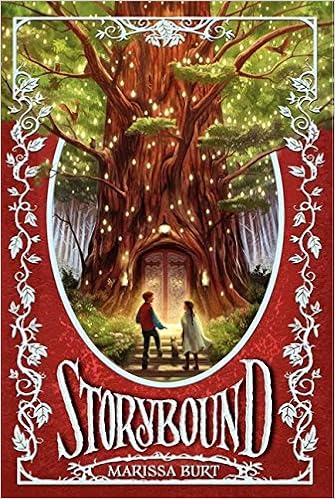
This book offers a clever twist on the middle-grade fantasy staple of meeting story characters in the flesh. In the land of Story, the citizens (called characters) live out Tales written for them, and schooling consists of learning to be a good Hero or Villain. When Una Fairchild is pulled from our world into theirs, she quickly begins to unravel a conspiracy underlying the kingdom’s history. The world building took a while for me to get my head around in this book, but by the end of book one I was looking forward to book two. Adults and older readers will probably see many of the twists coming in advance, but this is an enjoyable fantasy novel with a rich cast of characters.
The Last Last-Day-of-Summer, Lamar Giles
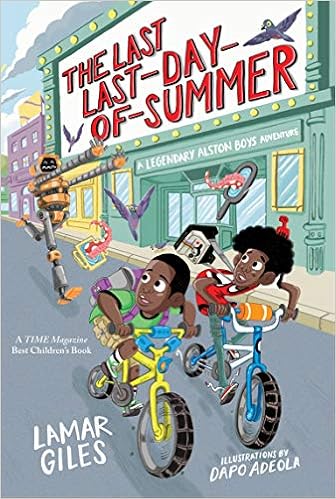
This book is bananas. B-A-N-A-N-A-S. When we join the Legendary Alston Boys, as the townspeople call them, at the beginning of this book, they’ve already had a wide range of supernatural-tinged adventures across Logan County, a sort of Sunnydale-esque locus of weird stuff. But then a mysterious being shows up with a Polaroid that freezes time when you take a picture. But then another mysterious figure zaps in to tackle him. Time is frozen across the region, and the Alston boys have to undo the damage, figure out who these people are, and work with an army of “Clock Watchers” with Phantom Tollbooth-level punning names. It is worth noting, given the author cofounded We Need Diverse Books, that the protagonists are Black and it is easy to assume, absent any information, that most of the other characters are as well.
The Extremely Inconvenient Adventures of Bronte Mettlestone, Jaclyn Moriarty

We’ve read a lot of British imports, and this one seems more British than most, even though the author is Australian (asides in this book and the others in the series about northern areas being warmer make a lot more sense now that I know that). I can’t quite tell you why; a certain quirkiness and polite air with stops for tea shouldn’t, on their own, be enough to make something seem British. The book itself looks like it’s going to be a series of loosely connected vignettes as Bronte Mettlestone is charged with visiting each of her aunts after her parents’ deaths. But they do eventually come together in an overarching elaborate plan that sees Bronte score a major victory against the Whispering King and solve a host of small problems along the way. Moriarty’s world of small kingdoms and dragons and pirates and wizards and slightly odd denizens is a lot of fun, and our daughter was eager to read more about it.
Cattywampus, Ash Van Otterloo

Magic is recent history in Howler’s Hollow, but not in a good way. The McGill and Hearn clans flung spells back and forth with such rancor and little regard for collateral damage that the townspeople banded together to put an end to it. Fast-forward to today, when Delpha McGill and Katybird Hearn are the last in line of their respective families. In Delpha’s household, magic is strictly forbidden, but when she finds her family’s spellbook, she sees it as a way to solve her mother’s financial woes. Katybird, on the other hand, grew up knowing about magic, even if her family keeps it under wraps, but she’s worried that her magic, which is passed from mother to daughter, will be okay, as she presents as female but was born with XY chromosomes. The two girls, who are at best acquaintances, meet up and accidentally unleash an undead army of both Hearns and McGills, who bring the full fury of the feud back with them. The girls have to work together and master their magic in order to save their town. The arc feels like it takes a beat too long to resolve, and it’s unclear what the girls have to do assuage the angry townspeople once the zombies are quieted, but it’s a good story overall.
The Tragical Tale of Birdie Bloom, Temre Beltz
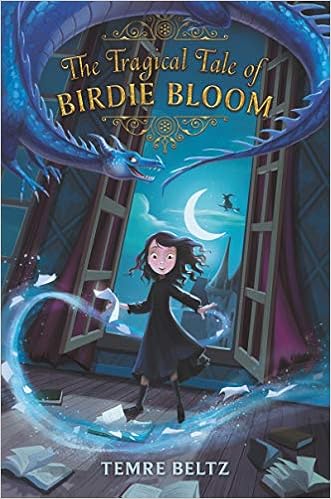
I really liked this fantasy book, though I’d be hard-pressed to pinpoint exactly why. Certainly the underlying themes of the power of friendship and combatting rigid definitions of who you are are good ones. And the book provides a novel take on the “imagine a world where fairly tale characters are real” genre of middle grade books. And the quippy narrator, who is in fact the book you’re reading, provides amusing editorials and footnotes. In Wanderly, Caucasian (by the cover if not the text) Birdie Bloom is a Tragical. Stories in Wanderly are fiercely controlled by the Chancellor. And you are destined to live the story written for you. Not all stories are happy, of course, which is where Tragicals come in: they are destined to have unhappy endings (unlike the Triumphants, winners of happy endings and suspiciously often drawn from upper classes). So Birdie lives a bleak existence, because why invest in teaching Tragicals how to do anything other than die unhappily? But then the deus ex machina of the Winds of Wanderly, a sort of omnipresent anything-is-possible magical entity, brings Birdie a letter written by a wicked witch who wants more from the book of spells than the Chancellor has allowed. A bit of initial identity confusion moves the two pen pals to form the most unlikely of friendships. The headmistress of the Home for Tragicals is like Miss Hannigan turned up to a million (minus the drunkenness), so she can be a scary character. But even she is given depth by the uplifting (and decidedly non-Tragical) end of the book, with a suppressed magical ability that brings to mind people forced to hide their homosexuality for fear of abuse.
The Tail of Emily Windsnap, Liz Kessler

This middle-grade fantasy series will definitely appeal to mermaid enthusiasts, as the titular character learns that she’s half-mermaid when she plunges fully into the water for the first time in her life. Before long, she’s made a mermaid BFF and started to unwind a conspiracy about her father, a neighbor, her mother’s odd memory lapses, and Neptune himself. The plot moves along through coincidence after coincidence, and raises a lot of questions, but if your child likes this kind of thing, this series is sure to be a hit. (Our daughter read the first two books but then got bored by the third.)
The 1,000 Year Old Boy, Ross Welford
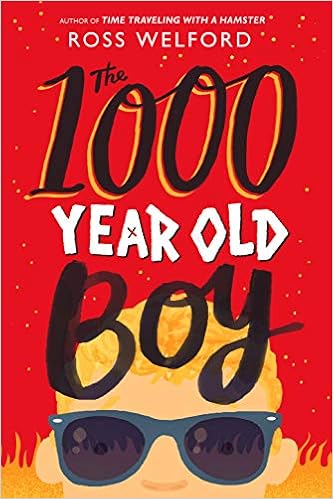
“Who waaaants to live foreveeeeer?” asks Queen. Not Alfie. Not anymore. A thousand years before the book’s time frame, Alfie used a “life pearl” that stopped him aging. He was 11 at the time. And in modern times, he still looks like an 11-year-old. But when his mom (also ageless) dies in a fire, he sets in motion a plan they established hundreds of years before: find the last life pearl they had hidden and set himself aging again. He recruits two kids in the neighborhood, and the three spend the latter third of the book tensely dodging another Neverdead who has stumbled onto Alfie and wants the life pearl for himself, archaeologists about to excavate the very site Alfie needs to visit, the modern kids’ parents, and child protection services. This book dwells effectively on the ups and downs of agelessness (which is different than immortality), and offers a sobering, thoughtful look on what that life might be like.
The True Meaning of Smekday, Adam Rex
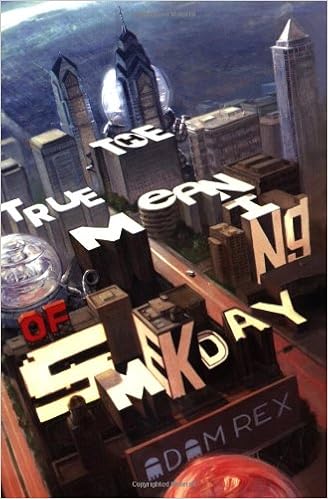
It’s not hard to spot similarities between this book and Mars Evacuees (below). In both, aliens have come to Earth and begun to corral humans. A human and an alien become friends, and then the two races have to work together to defeat yet another group of aliens. This book makes more explicit parallels between how the aliens treat the humans and how European colonists treated Native Americans, with humans put onto reservations, policies changed at the last moment, and so on. This book is a more humorous narrative, though, with Black protagonist Gratuity Tucci befriending a Boov who goes by J. Lo and eats all manner of things we don’t consider food (including sure-to-induce-giggles items such as urinal cakes). This book has a draggy middle part – I don’t understand what the Florida side trip added to the story other than a satirical look at a thinly-disguised Disneyland (Happy Mouse Kingdom) and probably 100 pages – but is mostly enjoyable and packed with silly sci-fi. It is evidently the basis of the movie Home, but reading the plot summary of that movie brings the phrase “loosely based on” to mind.
A Tale of Highly Unusual Magic, Lisa Papademetriou
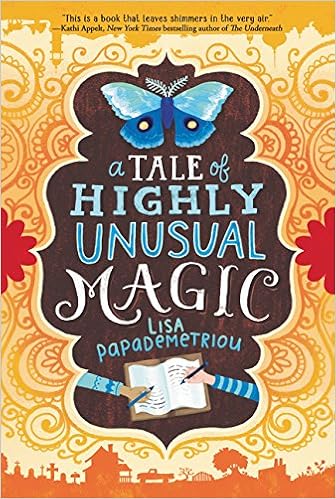
This book gives you three stories for the price of one! Kai and Leila, two girls who don’t know each other and are situated halfway around the world from each other for most of the book, each find a blank copy of a book called The Exquisite Corpse. When Kai, on an impulse, writes a sentence in her copy, not only does Leila see it and write her own sentence, the book itself begins to fill in its own story, incorporating elements of the girls’ lives. While the girls never learn of each other, they do each realize that they have their own connections to the real people described by the magical book’s story. Elements from one girl’s experiences bleed into the other’s in a magical realism way. There’s much in this book about magic hidden in the world around us.
Amari and the Night Brothers, B.B. Alston

When Amari gets a mysterious package on behalf of the brother she was told was dead, she finds an invitation to join the top-secret Bureau of Supernatural Investigations. She accepts so she can find out what happened to her brother, but quickly discovers that she is a Magician, a human with innate magical powers. Unfortunately, Magicians are viewed as unilaterally evil by the Bureau, so she immediately faces the same level of shunning and disparagement she faced as a Black girl in a largely white prep school. Bureau officials allow her to try out to be an agent, and she pairs with classmate Dylan van Helsing and her were-dragon roommate to find out what happened to her brother as well as Dylan’s sister Maria. If you liked the Nevermoor books, you’ll find a lot of similarities in this rich, fast-paced novel. My daughter tore through this and was excited to tell us all about it as she read it. You can read my longer review at Geekdad.
Toaff’s Way, Cynthia Voigt
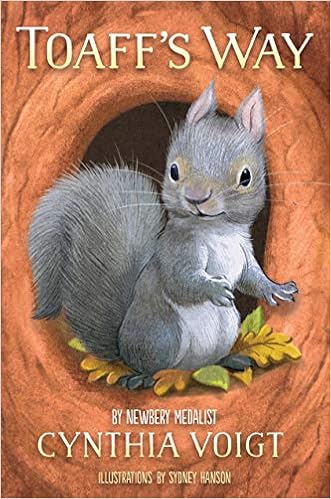
Oh, I loved the language in this squirel’s-eye-view story – a more common genre of middle-grade fiction than you’d expect – right out of the gate. “Sometimes everything was so wonderful all you could do was whuffle.” “…the squirrel voices were filled with slow churring sounds, not at all like the quick chuk-chukkings in his own den…” The rich soundscape of the farm where the book is set is on constant display. Cows muuh muuh, sheep bua bua, and dogs mostly yark. Or Yark! The farm – the setting for a number of Voigt’s books and seemingly her real life – is a wide world for the curious Toaff, who doesn’t just accept the things he’s told at face value. As the meditative story unfolds – the book spans a year of Toaff living his life – Toaff explores more of the farm and meets more of its denizens, all of whom have views about the world that sound humorous to our ears – my daughter was in stitches about the idea that the sheep had kidnapped a human to take care of them – but make sense from that tiny corner of the farm. There are some moments of scariness, but overall this is a gentle story that will let you see the world in a new light. Some cartoon-esque drawings scattered through the book give an extra touch of life to the narrative.
Castle Hangnail, Ursula Vernon
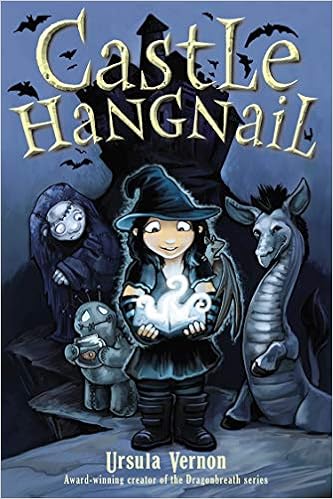
I don’t know that I can set up the premise better than the official description: “When Molly shows up on Castle Hangnail’s doorstep to fill the vacancy for a wicked witch, the castle’s minions are understandably dubious. After all, she is twelve years old, barely five feet tall, and quite polite.” This is a sweet story about a young girl who is maybe not quite as wicked as she claims to be. Though she is there because she stole – sort of? – the invitation to become Mistress of the titular castle. And she does have very Witchy boots. But despite the minions’ skepticism, Molly uses a tome of spells to win their trust and the hearts of the townspeople nearby, while also saving the castle from being decommissioned and realizing that the “friend” who helped her learn magic was manipulative and mean. Ursula Vernon writes often for the middle grade set, and she knows her audience. Jokes are aimed at kids but not overly gross, and the whole thing is quite gentle and easy. Definitely one for the Goth parents who will share Molly’s appreciation for black lace and dusty, gloomy castles.
Murder is Bad Manners, Robin Stevens
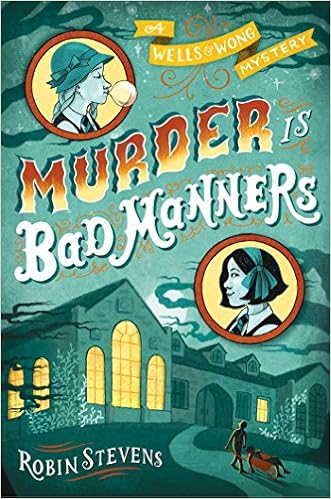
This clear homage to Agatha Christie books moves the action to a girls’ school in the 1930s and sets two middle-graders, Daisy Wells and Hazel Wong, as the detectives solving the crime. My daughter really enjoys this series – so much that we started buying the UK books that haven’t made it to the US yet. When Hazel discovers a dead body in the school gym, the two girls go to work to solve the mystery. Suspects are brought up and eliminated, clues are followed, and various leads get misinterpreted until the final reveal. I don’t know how easy the right answer is to get on one’s own; my daughter told me the ending before I read the book. Daisy is that insufferable pretty, upper-class child who everyone adores and gets away with anything she wants, more or less, and is clearly accustomed to that devotion. Hazel definitely faces some racism at the school – she’s from Hong Kong – but it’s a side thread and probably better represents Hazel’s day-to-day experience as it would be at that time period. See my longer review at GeekDad
Once Upon a Unicorn, Lou Anders
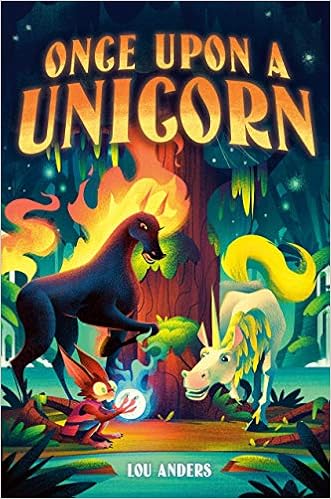
I thought I had the measure of this book pretty early. Enemy Mine trope between the main unicorn and the night mare – two species who can’t stand each other – plus a snarky, fourth-wall-breaking narrator. I figured it would be fun and fluffy. But actually the story takes some complicated turns that made for a richer, deeper story that builds on top of darker western European stories of Faerie. While none of the plot twists are particularly surprising, this is a book that has some depth but always stays pretty fun.
Mars Evacuees series, Sophia McDougall

One of my favorite things about this series was hearing my daughter try to pronounce the words and names from the alien species presented within. But aside from that, this is a pretty solid middle grade sci-fi book. Alice Dare, daughter of one of the most famous pilots fighting against the Morror aliens who have begun to take over Earth, is sent to Mars with a few hundred other kids to train as cadets. But a few months into their training, all the adults leave. Alice finds herself in a Lord of the Flies situation and leaves the base to find the adults along with her super-smart (and notably Black) friend Josephine, class clown Carl and his brother, and one of the teaching robots. While terraforming has begun on Mars, it’s still early and the kids have a tough go of it. Along the way, they meet a Morror and learn more about why the Morror came to Earth at all. By the end of the book, the Earthlings and Morror have teamed up against a common threat, thanks to the kids, and book two sees them meeting yet more aliens en route to a new Morror homeworld.
The Lost Treasure of Tuckernuck, Emily Fairlie

I would like to go to a school that has a decades-old treasure hunt buried in its walls and has a notable Victorian architecture. But Laurie, the main protagonist (Caucasian, like everyone pictured in the book), at first wants nothing to do with her new school; she’d much rather transfer to Hamilton, where her best friend goes. An accident, however, leads her and fellow “Clucker” Bud to the first clue of the founder’s treasure hunt, which is farther than anyone’s gotten before. The treasure hunt is fun in this book, but, much like York (see below), the treasure seekers seem to often happen across solutions by luck and without a lot of solving. In fact, they often seem poised to give up at the slightest challenge. While the characters are going through typical middle-grade challenges, I didn’t really feel like I got to know them very well. Still, there are fun antics and asides that kept my daughter laughing and eager to read the sequel.
The Inventors at No. 8, A. M. Morgen
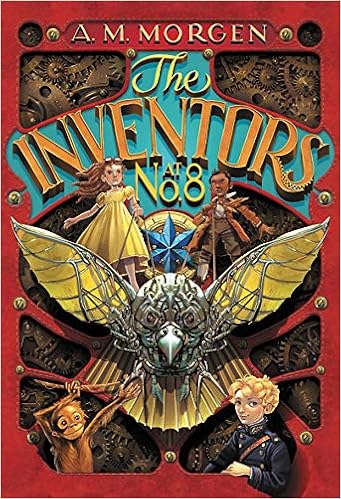
George, the 3rd Lord of Devonshire, has resigned himself to a dull life trapped in his home because of the curse of bad luck he believes he’s stuck with. And then Ada Byron, the future Ada Lovelace, enters his life. She buys a map that is his last possession and purports to tell the location of the Star of Victory, a maginificent jewel. The two set off to recover the gem with Ada’s friend Oscar and his organutan companion Ruthie. Their adventure takes them to Switzerland and Venice as they dodge the shadowy Organization and damage their friendship. The adventure itself is one of those silly things where it seems like everyone in Europe manages to know everyone else, and can be a bit convoluted to follow, but it’s a lot of fun and has numerous twists and turns.
Front Desk series, Kelly Yang

This series starts out with the semiautobiographical story of Mia Tang, a girl whose parents brought her from China to forge a better life. Unfortunately, racism and anti-immigration sentiment in the United States have made for hard going. But the motel where they’ve started working offers some hope. At least until the Chinese-born owner proves he’s just as willing to exploit them as native-born managers. Mia fumes at his callous and racist attitudes. When she applies to an essay-writing contest that looks to be a ticket out of her family’s drudgery, she discovers that writing – even as a non-native English speaker – is a skill that can be deployed in other ways as well. Pretty soon, she’s writing letters to help her friends, right wrongs, and build a community around her. The second book, Three Keys zooms out a bit to talk about how anti-immigration sentiment affects many lives, particularly her friend Lupe’s, but once again Mia rallies a community of kind people, many of them recent immigrants themselves. Mia is a great character: determined, creative, and possessed of a strong moral compass. And these books grip you emotionally with the ups and downs of her family’s struggles. Read my longer review of Front Desk at GeekDad
Property of the Rebel Librarian, Allison Varnes
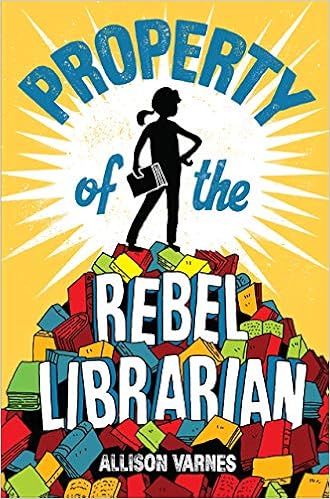
Oooh, this book had me fuming and exclaiming in outrage at every point. When protagonist June Harper’s parents find an “inappropriate” (maybe just scary?) book in her backpack, they go on a rampage to not only stop her from reading such books but to purge the school library of any texts they deem unacceptable. They take away June’s personal books and eventually return Bowdlerized versions with words crossed out, pages removed, and index cards with new endings pasted over the original pages. (Old Yeller now ends with “And they lived happily ever after.) But June almost accidentally begins a subversive counterattack, eventually pulling a huge section of the student body into her network of enthusiastic readers. It grows and grows until the inevitable denouement. While the situation doesn’t wrap up neatly, it does leave June feeling independent and sure of herself in a way that she didn’t at the beginning of the book. (And an overheard conversation suggests that her parents are both disappointed in her trouble-making but proud of how she comports herself when owning up to it.) Her lack of self-definition manifests as well in her crush on a wealthy boy who turns out to be a narcissistic bozo. A better relationship appears in the form of her underground library’s first patron and co-founder. There is much in the way of heterosexual middle-grade romance drama here, but also a lot of good opportunity to talk about reading, censorship, and what is right and wrong when it comes to controlling kids. There is a bibliography of banned books mentioned in the text.
Strange Birds, Celia C. Pérez

When Lane DiSanti decides to start a scout troop of sorts in her small Florida town, she ends up with an eclectic mix of four girls who serve as a counterpoint to “the Floras”, a historic socialite society for girls. The girls decide on an activist path that puts them on a collision course with the Floras, centering around a hat made out of bird feathers that dates back a hundred years or so. In addition to standard middle-grade themes of finding your own way and what constitutes friendship and meaning, the four girls represent a wide range of social perspectives that they are aware of and honest about. Aster, who is Black, talks often about “the Wall,” the invisible divide that separates the poor, largely Black side of town from the White side of town where, for instance, the DiSantis, a founding family of the town, live. Lane, meanwhile, is oblivious to her privilege and the town’s history. Cat, the bird enthusiast and former Flora, is a Cuban-American whose mother sees in her daughters a chance to continue their family’s social climb by participation in the Floras. Ofelia’s overprotective Latina mom works as an aide for Mrs. DiSantis. But the girls bond over their protests against the Floras and a desire for justice. And while no statues are torn down, the attempts to educate people about the mass extinction of birds that took place because of decorative hats has similar tones of re-evaluating historic icons and what it says to ignore that past.
A Pinch of Magic, Michelle Harrison

When Betty Widdershins learns the women of her family are cursed to never be able to leave their small community, she becomes determined to break the curse – especially after her two sisters are kidnapped to beyond the boundary, starting the clocks ticking on their imminent death. The three sisters are aided by three magical items that give them the ability to turn invisible, see far afield, or travel anywhere instantly. This is a tense adventure – the omens of impending death add a lot of anxiety and stress to an already fraught situation – that celebrates sisterhood, teamwork, and empathy. See my full review on GeekDad.
The Dark Lord Clementine, Sarah Jean Horwitz

The premise of this is clever: What does your life look like if you’re the daughter of a Dark Lord and heir to his power, title, and estate? Clementine lives alone with her father and is gradually learning what she needs to become a Dark Lord in her own time. But when her father gets cursed by a nearby witch, Clementine has to take on more of the estate’s responsibilities. She decides to figure out how to save him, and wanders off to find a cure. In the first act, numerous characters think about killing the nearby unicorn, though that confrontation doesn’t take place until the third act. In the second, Clementine makes new friends – which Dark Lords are not supposed to do – and begins to build not only a new “family” but also the confidence to find her own way. Early on, it’s clear that Clementine isn’t exactly standard Dark Lord fare, so don’t worry about rooting for the bad guy (or girl). Rather, the book touches on familial love even when nontraditional, the power of friendships, and the desire for independence.
The Ministry of S.U.I.Ts, Paul Gamble
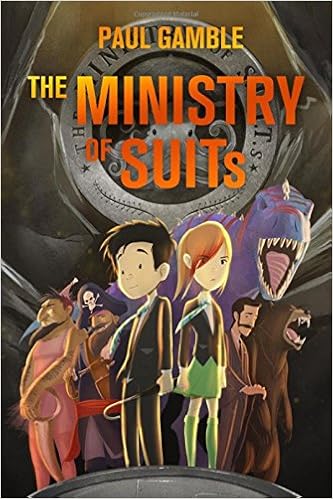
Picture Men in Black, but written for middle graders and filtered through a lens of Monty Python, Douglas Adams, and other absurdist humor influences, and you’ll probably get pretty close to the tone of this book. Northern Irish protagonist Jake is an observant kid who wonders about all sorts of things, and makes logical leaps that seem bizarre to our ears but, in the world of this book, end up being pretty much exactly right. These bounds lead him to become a member of the Ministry of Strange, Unusual, and Impossible Things where, along with fellow schoolmate Trudy, he uncovers a massive plot based on clues such as smelly gym clothes. The twists and turns are, unsurprisingly, unpredictable and silly, and equally silly footnotes and sidebars show up frequently. There’s some fat-shaming and other elements that feel a bit lazy (thuggish male Tooth Fairy in a pink tutu), but overall this is a zany adventure that my daughter really enjoyed.
Girls Who Code series, Stacia Deutsch
The slim books in this series hold fairly typical upper-elementary/middle-grade themes – friendship, collaboration, misunderstanding – set against a backdrop of girls learning to program and make their ideas come to life. This book is enthusiastic about girl programmers: Lucy’s mom is a programmer, and the coding club she’s in seems to be predominantly girls, all of different races and backgrounds. The first book walks you through the key things you need to know about programming: input/output, conditionals, loops, and variables. But not in any recognizable programming language, which is obviously part of the point; those concepts exist in every language. One thing I really enjoyed about this series is that everyone is full of ideas about programs they want to write. It’s not just about writing a game, which is where most “get kids coding” efforts start, but about writing programs that solve a problem, whether it’s reminding a beloved relative to take their medicine or helping sick kids get homework from classmates. I feel like this really respects kids’ ideas and helps underscore the fact that programming is a tool that can help across a wide swath of problems relevant to their lives.
The Uncommers series, Jennifer Bell
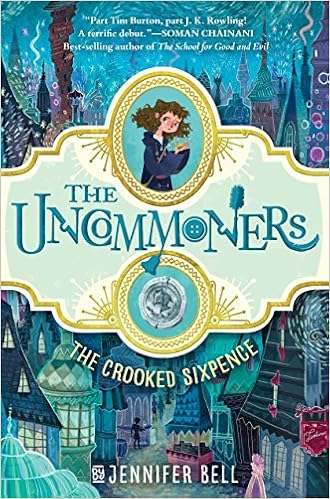
As the book starts, Ivy Sparrow is riding in an ambulance with her grandmother Sylvie, who has taken a tumble. But at the hospital, she notices an odd man in gray with mangled hands. Then her grandmother’s house gets raided. And officers in black regalia show up wielding toilet brushes. Before long, Ivy has found herself in Lundinor, a city thriving well under London, right in time for an undermart, where a group of people who call themselves uncommoners trade magical objects a couple times a year. Uncommon lemon squeezers cast light, uncommon belts let you fly, and uncommon bells give you helpful advice. Ivy and her brother find themselves in a race to rescue her parents from the evil Dirge, who are very interested in what happened to Grandma Sylvie decades before. The blurbage for this says “For anyone with a Hogwarts-sized hole in their heart,” and I can see similarities. Everyday objects with magical powers, a fantastic world right under our noses, and odd attire. Perhaps it was simply the timing of the first book’s arrival that invited the comparison; there are plenty of differences (even beyond having a girl as protagonist) and Lundinor is its own world with plenty of unique elements. The books are fast-paced adventures that will have you at the edge of your seat and jealous of Ivy’s magical experiences. There are a handful of wonderful illustrations throughout to catch the eye.
Granted, John David Anderson
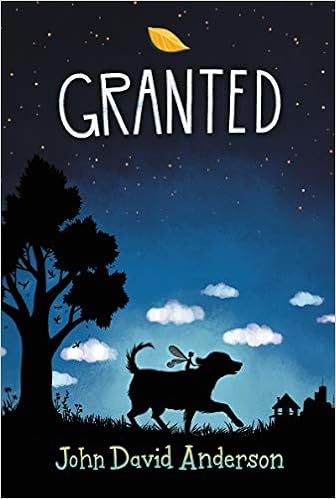
I was taken with this book from its very beginning, with its meditation on wishes and its imaginative bustling fairy city. Even the names – Ophelia Delphinium Fidgets is our protagonist – get a moment of explanation. When Ophelia, a “Granter” who actually grants wishes and keeps magic flowing, sets off on her first wish-granting mission, she’s thrilled and fairly cocky about it. Given that her mission starts off early in the book, it’s not hard to imagine that it quickly goes off the rails. One might imagine something like The Night Fairy, and there are similarities, but Ophelia isn’t a naive, wondering observer of the human world. Fairies who leave Haven need to study up on humans and our customs and devices. But Ophelia learns that book smarts and training can only take you so far. One is reminded of Wesley Wyndham-Price, in Buffy the Vampire Slayer, bragging upon his arrival that he has faced two vampires. Under controlled circumstances, of course. Ophelia goes from dogmatic rule follower determined to complete her mission to independent thinker determined to do the right thing, and you’ll find yourself solidly on the side of the rule breaking she does at the end. The book is filled with humor – Ophelia’s magic fairy song that beguiles listeners is Crazy Train – warmth, and touches of sorrow, and it has a deeper message about home and happiness. Note for sensitive readers: The dog she meets on her adventures has clearly been abandoned and abused. Not horribly, but enough to give him a sobering backstory and in turn make him distrustful of human loyalty.
Kiranmala and the Kingdom Beyond series, Sayantani DasGupta
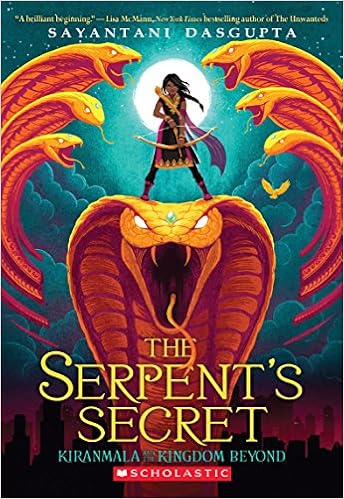
This will inevitably invite comparison to Aru Shah (see below). Both feature South Asian tween girls flinging pop culture references left and right while embarking on an adventure steeped in an Indian mythology after learning they’re royalty of some form or another. But the Kiranmala books are more about Bengali myths, which may or may not be lost on the average Western reader. Kiranmala is also older than Aru Shah and is noticing boys – especially cute boys – more than her Rick-Riordan-stamped contemporary. The settings in the Kiranmala books are also more bonkers, involving trips through interdimensional pathways and describing scientific concepts such as neutron stars and black holes as gems and demons that we can’t understand in our 2D world where we want simple explanations. The Kiranmala books are fast-moving adventures that take twists and turns and ultimately talk about tolerance for others and feature a princess who wears combat boots and abhors the Pretty Pink Princess line of toys. There is artwork sprinkled throughout, but drawings are few and far between.
Casey Grimes: The Mostly Invisible Boy, AJ Vanderhorst
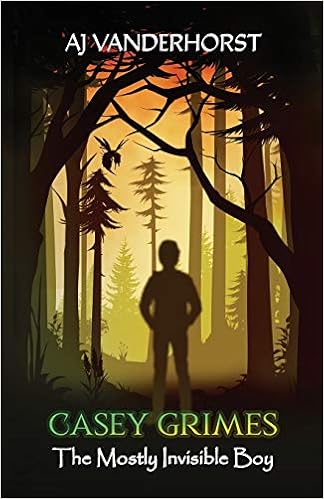
Casey Grimes has spent the school year lonely and frustrated by his near-invisibility. If he makes a loud noise, a fellow student might notice him for up to a few seconds. But then it will be as if he didn’t exist. His loneliness spurs him deep into the nearby forest, where he finds and climbs a monstrous oak tree. High up in its branches, he discovers a magical world named Sylvan Woods, where the parents are off at “the front” battling nightmare versions of our forest wildlife and the kids are learning how to take their own positions as defenders of the forests and “Civilians” such as Casey and ourselves. There’s lots of nature appreciation in this book, as well as adventure and magic. You can read my longer review at GeekDad.
Caley Cross and the Hadeon Drop, Jeff Rosen
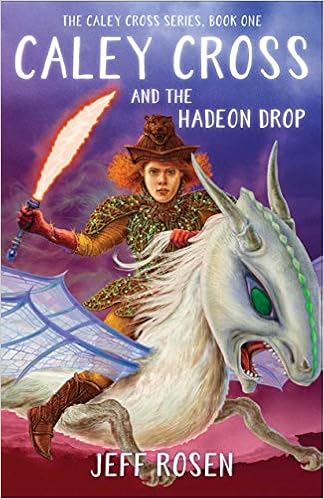
Caley Cross is just your typical Caucasian 13-year-old at the beginning of this book, the first in a new series. Except for the fact that she lives in an abusive orphanage and can reanimate dead animals. But after one such zombie incident, she’s whisked off to the world of Erinath, where it turns out she’s the long-lost highest-ranking princess, daughter of the former Queen. In Erinath, children bond with creatures – their “baests” – who shape their magic and their lives in unique ways. While she soon makes some fast friends, she also soon meets a mean girl intent on humiliating her and learns that an evil Watcher is after her. There are some fat jokes, and one characters whose whole existence seems to be so the authors can mock “political correctness,” but this is a fast-paced adventure story with many thematic elements in common with Harry Potter. You can read my longer GeekDad review as well.
Freya and the Magic Jewel, Joan Holub & Suzanne Williams
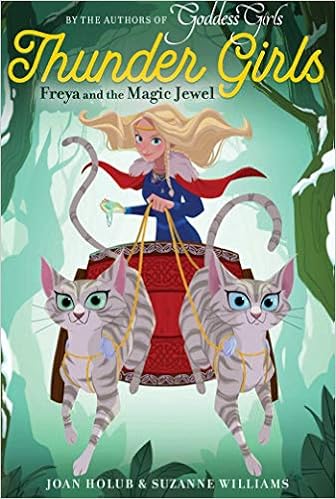
I checked out this book because I was drawn to cover art of a blond goddess with a twinkle in her eye in a chariot pulled by tabby cats. But the story reduces the Norse god of love and beauty to a ditzy teenager enrolled in Asgard Academy. Who! Narrates! Her Life! With! Lots of! Exclamation Points. My daughter enjoyed this middle-grade Disney-esque view of Norse mythology – first in a series – well enough, but I found the book teeth-gratingly annoying and the primary character mostly unlikeable.
Mrs. Smith’s Spy School for Girls, Beth McMullen
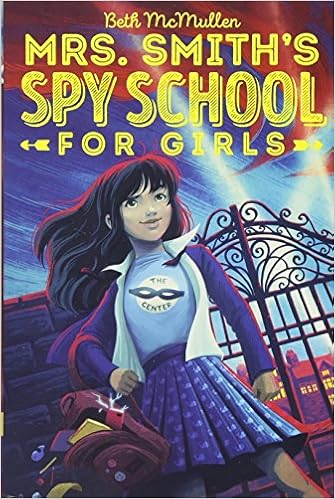
This book starts off a bit slower than you’d expect from the description, but by the middle of the book it’s a tense series of narrow escapes from duplicitous villains, with a few twists thrown in for good measure. Abigail Hunter, the smart and smart-aleck Caucasian narrator of the book, has been shipped off to a prestigious boarding school in Connecticut. But she soon discovers that there’s a school within the school: one focused on using girls and young women as spies “because no one notices kids.” She also discovers that her mom is actually one of the spy school’s most legendary alumni and has gone missing. She’s set up as bait to get her mom to resurface – ideally along with crucial information about beating the mysterious Ghost criminal mastermind. This is book one of a series.
Grounded: The True Adventures of Rapunzel, Megan Morrison

You know the story of Rapunzel, but what about all the people affected by her loss and the story of her imprisonment? And why exactly did the witch keep her in the tower? When this book’s Rapunzel descends from her tower along with Jack (of the beanstalk), nearby fairies set her on a quest and forbid her from contacting the only love she’s ever known: Witch, who keeps her in her tower and tells her horrible tales of the world below. (This is an amusing reversal of the “I’m a mistreated nobody in my own life, but someone special in this other one” genre of middle-grade fantasy.) But, as you might imagine, Rapunzel soon learns that the world has many good things and that Witch is more than just a loving parent. Is in fact something more sinister and feared by the people of Tyme. Rapunzel’s quest seems to go relatively easily, with few things being scary for very long, and she is often helped along by good people who know her story (who, refreshingly, are described as being a wide range of human races), but I really liked the way this book meditates on family and love and how complicated it can be. There’s a lot of clever ideas in these books.
Dragon Pearl, Yoon Ha Lee

Protagonist Min is a real fox. A supernatural fox that is, one of the magical creatures drawn from Korean mythology that accompanied humans to the stars. While most of the supernaturals – dragons, tigers, goblines, and more – have found places in society, albeit not always to the comfort of their human colleagues, foxes are viewed with suspicion and most people think they’re extinct. Foxes like Min can shape shift and use Charm to influence the feelings of humans and supernaturals alike. While her mother urges her to repress her Fox powers, Min must bring them fully into play when she sets off to rescue her brother Jun, a Space Forces soldier accused of deserting his post in order to go after the fabled Dragon Pearl, which has the ability to terraform planets quickly and easily. This is a well-written, fast-moving space opera, full of adventure, twists, and shifting alliances. While complete in itself, the book does set up for sequels. In an au courant nod, Lee’s universe’s ID cards contain pronoun preferences for the person, and, indeed, a significant character prefers gender-netural they/their/theirs.
The Twelve, Cindy Lin
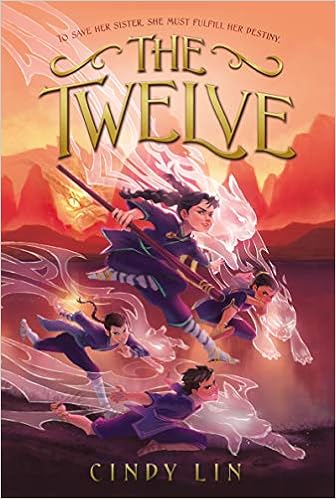
In our world, astrology is total fiction. But in this first book in a series, being born in, say, the Year of the Rabbit might give you rabbit-like powers. Usagi (the whole cast is implied to be of Asian descent) is one such girl with zodiac powers; she can hear quiet noises from far away and make tremendous leaps. When her sister is abducted by the Dragon Lord, who has seemingly purged the land of those with zodiac talents, she has to journey to Mount Jade to master her powers and rescue her sister. This book is a solid adventure with lots of magic and martial arts, and the story takes some twists, though adults may see them coming. It sets up nicely for the sequel, which we’re looking forward to and promises a Catradora-esque antagonism – but without the lesbian denouement – along with a magical-item scavenger hunt. My daughter really liked this story.
Code Busters Club series, Penny Warner
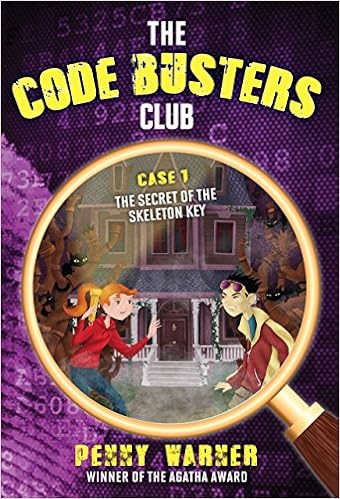
If your kid is going through their inevitable secret code phase, they may enjoy this series about four multiethnic kids who like to solve codes, ciphers, and other puzzles. The mysteries are pretty straightforward for adult readers and bigger kids, but throughout the book you’ll find coded messages that you can solve right along with the characters. If you get stuck, the back of the book has keys to help you along, and if you get really stuck, the books also feature the answers. There’s a bit of stereotyping here: the Asian kid is good with computers, the Black kid is athletic and from the South. There’s also some heteronormative crushing between protagonist Cody and Luke, and at one point in the first book, ME suggests to Cody that her nemesis is mean to her because he likes her, which is not okay messaging for girls. Still, this series features way more codes and ciphers than other similar books, and even a secret codes devotee is sure to learn some things from them.
Unicorn Quest series, Kamilla Benko
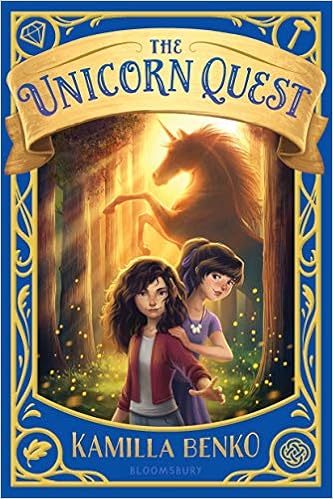
It doesn’t take too long for this book to get going as Claire and her big sister Sophie (both drawn as Caucasian on the cover) climb a ladder they find in their great-aunt’s fireplace and end up in an entirely different world. Benko’s Arden is a wonderfully constructed world, with four magical guilds that, in modern times, are tensely peaceful but don’t intermingle. Claire, the younger sister, figures out that Sophie has been going back to Arden on her own and sets out find her and bring her home. Along the way, the sisters encounter perilous situations and twists aplenty while also learning of their own connections to the magical land. The text in this moves along smoothly, and Claire is a likable, well-fleshed-out, independently-minded character. My daughter and I both really liked these books. I wrote a longer review for GeekDad.
Wildwood Chronicles, Colin Meloy

Portland-based Prue (drawn as Caucasian which I suppose makes sense for Portland) is babysitting her toddler brother one day when a murder of crows descends upon the wagon he’s in and carries him away to the Impassable Wilderness (the book’s analog to the parks and forests south and west of the city across the Willamette). When Prue sets out to rescue him, she and her friend Curtis (possibly bi-racial, hard to know) quickly find themselves in a separate land whose citizens are engaged in a power play involving a corrupt government in the South; bandits; a power-hungry Dowager-Governess; the Avian Principality; and the rural, peaceful North Wooders. The two (who are separated soon after they enter the woods) get involved in battles both small and large and make new alliances and enemies, and Prue learns more about her own connections to the land. There are similarities to The Lion, the Witch, and the Wardrobe, especially with regards to the talking animals and the first book’s Dowager-Governess and her White Witch-esque antics. I’m not sure how I feel about the only other main female character being a trope-y woman driven mad by the loss of her son who is now bent on world-destroying vengeance, but I actually think the book has some good things to say about the deeper complexities going on politically, and more girls are introduced as principals as the series continues. It’s certainly a good adventure! And the third book ends after an epic conflict. If you’re familiar with Meloy’s songs for The Decemberists, you won’t be surprised to find that the Wildwood world is quirky and rich. This book does have very lovely illustrations, but it’s a hefty book in its own right (at the time, probably the largest book my daughter had read), so I’ve kept it here.
Aru Shah and the End of Time, Roshani Chokshi

Part one of a series under the Rick Riordan stamp, which is basically him taking the fame he garnered writing Greek mythology fanfic and helping boost people writing about other mythologies. In this case, Aru Shah is of Indian descent and, it turns out, one of the reincarnated Pandavas. Once she lights a cursed lamp to prove to her classmates she’s not lying (which she often does), she is thrust into a quest with another Pandava reincarnation (all girls, in this series) to defeat the awakened Sleeper before he stops all time. The series (of which I’ve read book one but my daughter has read one and two) is full of references to pop culture and Hindu stories, at least the ones the author heard as a child, according to her author’s note where she notes the difficulty of nailing down “one version” of Hindu mythology. I have to say I wasn’t overly fond of Aru Shah (the girl) when I started the book, but I ultimately came around. She starts out as whiney and a bit unrepentant but does eventually find her footing, even if she doesn’t exactly succeed the way you’d expect.
The Vanderbeekers of 141st Street, Karina Glaser

This series is often compared to the Penderwicks (see below), and it’s not hard to see why: a sprawling group of siblings having everyday escapades and managing their relationships with each other and their lives. But while the Penderwicks are, as a friend says, “not just white but New England white” who vacation in the Berkshires, the Vanderbeekers are a biracial family living in one apartment in a New York City brownstone. The first book sees them trying to prevent their family from getting evicted at the holidays, and I really liked it. The family is quirky and boisterous, with diverse personalities among the kids. They’re engaged with their wider community and the social issues facing it. The way they tackle their problems is what you’d expect from modern-day kids. The family felt real and warm.
Greenglass House, Kate Milford

I liked this first book in a series quite a lot and stayed up late one night finishing it. On the surface, it’s a decent closed circle mystery featuring a number of guests who get themselves to the titular house – in the book an inn frequented by smugglers – for various personal reasons tied to the house’s history. But those reasons begin to come out as guests find their belongings stolen. Milo, the owners’ son, investigates the thefts with the help of his friend Meddy. By the end of the book, you’ll have gotten an in-depth look at the house’s history, a good sense of the many guests, and a burning desire to visit the fictional house and hole up there with a good book. Though arguably set in contemporary times – the war of 1812 is referred to as “a couple hundred years ago” and the house has a backup generator – there are definitely some magical elements that get stronger as the series progresses, and trappings of the modern world such as cell phones are absent. One thing I quite liked about the book is that Milo and Meddy turn the investigation into a roleplaying game, and the author often uses their character names in the narration, as Milo in particular imagines himself as his alter ego and thinks like him. (Note that Milo is adopted and of Chinese descent, but the author deliberately didn’t make that the whole point of the book. Still it’s a strong undercurrent and informs a lot of his reactions.)
Book Scavenger, Jennifer Chambliss Bertman

Imagine geocaching for bookworms, and you’ll have a sense of the Book Scavenger game that protagonist Emily loves to play (and that you can, too, in this world). People hide books and then leave clues about where they could be found. The person who finds it logs it and sends it on its way. But when Emily (who seems Caucasian, but that could just be my own bias) comes across an unusual book soon after her move to San Francisco, it turns out that it’s a new, unannounced game from the Book Scavenger creator. But other people want the great treasure promised by the book, and Emily and her new friend James (of Chinese descent) have to balance a new friendship, an all-consuming puzzle, and thugs looking to cash in. While the plot is straightforward and enjoyable, I really like the way Bertman writes about the actual process of puzzle-solving. Aside from a perplexing passage in the beginning (why would you rearrange letters if you know something is a substitution cipher?), Bertman clearly knows what it’s like to go on a puzzle hunt. Sometimes inspiration strikes in weird ways. Sometimes you just have to grind through the mechanics. Sometimes you turn to Google. Sometimes you need a friend’s perspective. A parallel thread about a classwide cipher challenge offers a peek into the wide world of codes and ciphers, and Emily’s hunt through San Francisco features many familiar sites to natives as well as some of the city’s rich history.
Lalani of the Distant Sea, Erin Entrada Kelly

One blurb I saw about this book described it as “Moana meets From the Mountain to the Moon” (see below). I very much agree with the latter – the beautifully written book features a young girl on a quest that involves stories within stories in a universe of Filipino mythology. The former? I’m not so sure about, other than the fact that at some point Lalani is in a boat and her home island is having a bad spell. Where Moana is the daughter of a village chief, Lalani is a girl in a low social class – a double whammy in the sexist society where she lives. When her mother falls ill and Lalani feels her own actions have endangered her village, she sets off to find the legendary island of Isa, where riches and happiness flow. But even Isa is not perfect, it turns out. The book leaves some questions dangling, deliberately I think. But you really get to know the characters and cheer their growth. Along the way, Lalani encounters a number of monsters, but manages to persist and ultimately triumph.
Jinxed, Amy McCulloch

Do your kids like robots? Pets? Intense robot battles? Smartphones? Then this may be the book for them. This “Make: Magazine” bingo card of a book features a brilliant young (half-Chinese?) maker who dreams of being a companioneer – the people who make baku, highly capable robot companions that provide the tech of a near-future smartphone and the comfort of a near-future robot companion – who comes across a ruined baku and slowly repairs it. But it turns out Jinx isn’t like other baku. (I mean, it’s in a cat form, so I suppose that’s to be expected) He quickly secures a spot for her at her favorite school, and steers many of the events that underlie the book. I worried that this would end up being a “tada, it’s actually magic” book, but they do keep Jinx’s differences rooted in science fiction, explaining Jinx’s behavior as self-writing code and maybe a sentient AI. The baku battles are intense; adult readers may see analogs with dogfighting, while younger readers may find them too much. There’s some middle-grade heterosexual romance that doesn’t really add to the plot, but there are also open questions about what AIs may begin to ask of themselves.
The Girl Who Drank the Moon, Kelly Barnhill

This book starts out as a gut-wrencher, at least for parents: Officials taking away a new baby from a distraught mother to offer it to the witch in the woods. There is a witch in the woods, but she’s somewhat befuddled by why the villagers abandon a kid each year. So she takes the kids and relocates them to other villages, where they often enjoy blessed lives thanks to the starlight the witch feeds them. But one year, she feeds the abandoned child moonlight, which fills her with intense, powerful magic. Xan then decides to raise Luna herself to try and contain her abilities. But once Luna reaches her 13th birthday, the protections begin to fade and some ancient history involving Xan resurfaces in dramatic fashion. This Newbery winner is an intense book. It’s theoretically a kids book, but there’s a lot going on, and there are definitely dark parts of the story.
York: The Shadow Cipher, Laura Ruby
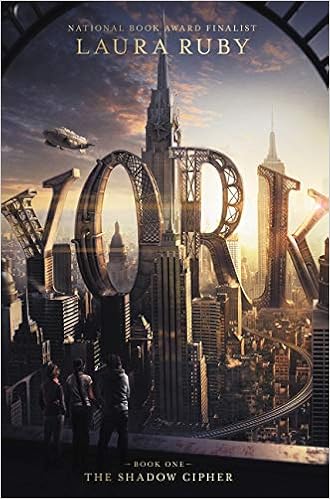
Oh that we could live in the New York imagined by Ruby in this first book in a series. In her alternate universe set in present day, New York runs on solar power, the Hudson is described as “clear and blue”, very sophisticated robots take care of all sorts of menial tasks, and a mysterious puzzle overlays the entire city. All of these advances came thanks to the Morningstarr twins in the late 1800s, but even in this reality, rapacious landlords seek to unhome long-standing residents. When Tess and Theo and their friend Jaime find a clue that suggests there’s a different cipher to solve, they set out to find the treasure and save the historic building they’re about to be evicted from. There’s a recurring theme of how what’s important isn’t always a big flashy thing but the myriad of normal everyday things that make up a life and a community. While my daughter really enjoyed this leaping puzzle hunt, as an avid puzzle solver I was disappointed to see little in the way of the reality of puzzle-solving. The multiethnic cast of protagonists seems to mostly solve the clues in this parallel cipher by way of intuition and luck, only occasionally going into the mechanics of how a puzzle worked. The fast-paced story doesn’t end the way you’d expect, but it does set up a premise for a really interesting second installment.
Nevermoor series, Jessica Townsend

I quite like (and my daughter loves) this series about Morrigan Crow, a Caucasian (at least according to the cover) child born on Eventide and thus cursed to die on her eleventh birthday. Instead of dying, though, she’s whisked away to a magical place called Nevermoor, where she is entered into a series of trials to enter the Wundrous Society. There are obvious parallels to Harry Potter here – an eleven-year-old taken from an abusive home to a magical realm, magical buildings and people, a school course load that will make kids envious, and a Chosen One trope – but the books have their own vibe and the world feels wholly unique, especially by book two, when the author gives us a deeper look at Nevermoor and its many ways. The book gets pretty dark even by book two, but the “bad wizards bad and good wizards good” simplicity of Harry Potter is replaced by a more nuanced view. The Wundrous Society is a magical institution, but it’s not hard to catch a fair amount of class resentment against its members. The Big Bad has clearly done bad things and is painted with a menacing brush, but he also helps Morrigan because he needs an ally in a larger fight that we are as yet unaware of.
A Tale of Magic, Chris Colfer

This first book in a new series is a prequel to the Land of Stories (see below). However, it warrants its own entry because it’s clearly a more personal story. Rather than weaving together disparate Western fairy tales, Colfer has to provide the history of his own creation, so he gets to do some world-building independent of canonical fairy tales. Also, it’s a fairly heavy-handed metaphor for the way gay people have historically (and, sadly, still) been treated. In his world, magic is something you are born with, and not necessarily along genetic lines. Magic children are beaten and abandoned by their family and their governments. There is even a point later in the book where someone talks about “coming out as magic.” Colfer has clearly matured as a writer; this first book feels tighter than the Land of Stories books.
Circus Mirandus, Cassie Beasley

Things are not going well for Micah. His grandfather, who took him in after his parents died, is dying, and his grandfather’s sister has moved in to tend to him. But she thinks the magical tales Ephraim tells are hogwash. Micah doesn’t, and pines to experience the Circus Mirandus himself. His grandfather arranges for a letter to be sent asking the illusionist known as the Lightbender to give him the miracle he’s owed. Thus begins a journey in which Micah gets to visit the circus himself, along with his skeptical friend, who can’t see the circus until she believes, at least a little, in its magic. There are some solid tropes here, but the story puts a new enough spin on “believing in magic makes it real” that even adults will enjoy it. The story is also fairly deep and sets up nicely for the sequel. The sequel, The Bootlace Magician is a more typical adventure, and it immerses you deeply into the circus’s world, but you need to know what’s in the first book before reading that one.
The Vengekeep Prophecies, Brian Farrey

Jaxter Grimjinx comes from a long line of proud thieves and con men. It’s too bad he’s not really good at the family trade. But he has a different set of talents that become required to save his town after a family con goes unexpectedly awry. This fast-paced and adventure-packed Hero’s Journey, the first in a series, sets up a believable magical world that will keep readers eagerly turning the pages. I appreciate the fact that Jaxter’s advantages and abilities to survive his adventures come from studying and knowledge of arcane lore rather than physical skill.
The Land of Stories series, Chris Colfer

Tweens Alex and Conner tumble into a book/portal and find themselves in a world populated with the mainstays of Western European fairy tales. Cinderella, Sleeping Beauty, and Snow White have all married brothers from the Charming royal line. Goldilocks is a fugitive after her initial breaking-and-entering crime, Jack from the beanstalk is in love with her, and Red Riding Hood is a democratically elected queen in love with him. In the first book, the twins have to go on a scavenger hunt for iconic storybook items to assemble a spell that will let them get back to their (our) world. There are definitely some more mature things in here that older readers and adult readers may catch that younger readers probably won’t – in the first book, Conner remembers the location of a secret door because it’s next to a painting of Red Riding Hood in nothing but a wolf-fur cape, and she is also described as “showing a lot of skin” in a shoulderless gown. I would also note that the population fits the Western Europe origins – one fairy on the Fairy Council is specifically called Black, so we have to assume the entire rest of the land is Caucasian. A final battle between Red Riding Hood and Goldilocks in book one uses a lot of gendered insults – harlot and the like. Our daughter and other kids really love this series, and it’s become a big franchise for Colfer. Adults will find it enjoyable enough, if also not well-edited.
Operation Frog Effect, Sarah Scheerger
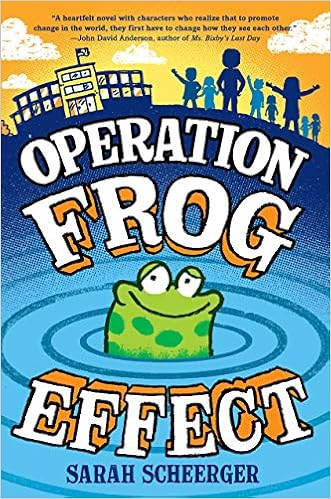
In this unusually formatted book, the reader gets an over-the-shoulder glance at fifth-grade journals. Typical (and not so typical) middle grade drama plays out not through straight narration but by putting connections together across the journals of eight students. One does hers all in poetry while another does his in screenplays and yet another does his in graphic-novel format. You get a peek into the troubles and triumphs of each student’s life (from kids living in a garage to kids living in a mansion, kids going to private school and kids dealing with immigration issues), and the final act will have you cheering for the students’ activism.
The Magnificent Mya Tibbs: Spirit Week Showdown, Crystal Allen
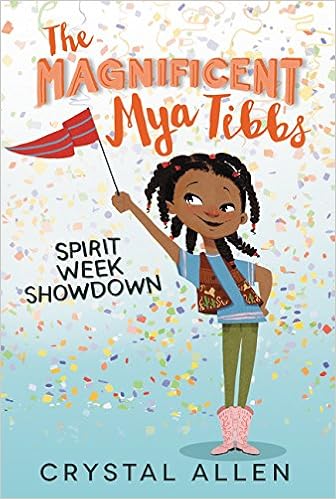
I’ve read a lot of best-friend drama – a staple of fiction aimed at elementary and middle school readers – at this point, but this was easily one of the most tense of those I’ve read. The titular Mya Tibbs is a character who stands out from the middle-grade genre: a cowgirl-loving African American who lives in Texas. In this first book in a series, she finds out that her best friend is not so much of a friend and that the school “bully” is a thoughtful, kind person. Even knowing this early on, I was at the edge of my seat as Mya navigated this growth during her school’s Spirit Week.
From the Mountain to the Moon, Grace Lin

Inspired by Chinese folklore, this quiet and poetic Caldecott winner features a young girl, Minli, venturing off to see the Old Man in the Moon and ask for her family’s fortunes to be changed. Along the way, she encounters a range of characters, including a dragon who becomes a fast friend, who tell their own stories, which seem at first to be unrelated but ultimately all tie together in a rich tapestry that builds Minli’s world effectively. By the time she actually gets to the Old Man, she’s learned a lot about herself and what’s really important in life. Some chapters focus on her parents and their reaction to their daughter’s disappearance. There are illustrations in the book, again inspired by Chinese art, but they’re sparse enough to keep this book in this list.
Eleven Birthdays, Wendy Mass

Think Groundhog Day for the middle-grade set. Amanda’s eleventh birthday is going pretty poorly, which is a shame, since she’s about to go through it ten more times. Turns out she and her once-friend Leo are stuck in a loop until they figure out how to get out of it. The actual resolution is hard to see coming, which is unfortunate, but along the way the kids do all the normal stuff you’d expect someone to do if they were stuck in this kind of loop. But over the course of the many birthdays, Amanda and Leo become friends again and become more sure of themselves. This is book one in the loosely connected set of books that make up the Willow Falls stories.
The Key to Extraordinary, Natalie Lloyd

I found this book really moving and thoughtful, with a number of layers, a good mystery, and strong messages about what’s important to honor and love. Emma comes from a long line of extraordinary women who call themselves the Wildflowers. At some point, each has a dream that tells her her destiny. When Emma gets hers, she thinks it means one thing, and it does, but not in the way she thinks. The book is infused with magical realism or light fantasy, with magic unusual but also commonplace in this town. Adults may see the twist coming early on, but it doesn’t change the intensity of the emotion. Emma has lost her mom before the book begins, and she refers to her feelings as The Big Empty or the hole in her heart. Lots of good thoughts about family and friends in this book set in small-town Tennessee.
Pie, Sarah Weeks

Ipswitch’s extraordinarily famous and talented (and economically self-sufficient thanks to inherited wealth) pie maker, Polly, dies without warning and leaves her piecrust recipe to her cat and her cat to her niece Alice, the protagonist. After that, various kid-appropriate hijinks and capers ensue until the mysterious bequest gets figured out. There are some odd scenes in the book – a teacher whose bodybuilding horrifies her students being the most notable – and the book adopts a tone that adults might find overly nostalgic for 1950s small-town Americana. Everything is resolved, a bit too neatly, right at the end, though the recipe inheritance has a nice twist. The book ends with a touching epilogue but doesn’t really go into how the small town survived a massive hit to its pie-tourism income. Pie recipes (appropriately without recipes for the crust) form chapter divides, which will make you eager to bake by the end. I’ll also note that while Polly and Alice prefer vegetable shortening for their crusts, lard is a better candidate in my mind.
The Penderwicks series, Jeanne Birdsall

This lovely series introduces the Caucasian Penderwick family: four sisters, a dog, and a widower father. The girls range in age from four to twelve in the first book, and the series follows along as they get older. The girls are richly drawn and have complicated relationships with each other, exasperated and loving at the same time. In the first book, they’re vacationing in a “cottage” (that allows each family member to have their own bedroom and a study for the dad) that is on the grounds of an estate in the Berkshires. So you can expect fairly middle-class issues. Crushes and first kisses are definitely in play.
Nothing But Trouble, Jacqueline Davies
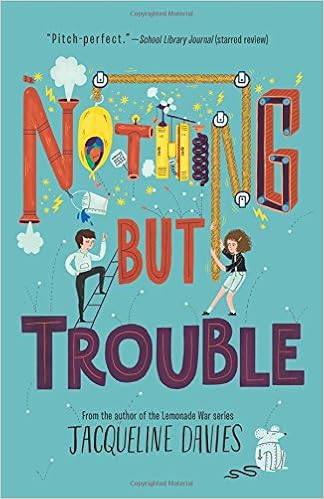
I really enjoyed this book about Maggie, a science-and-engineering expert who delights in elaborate MIT-hack-style pranks, and her new arty friend Lena. The book features lots of fun pranks, but also touches heavily on small-town life (both good and bad aspects), dreams that succeed or fail, and getting students engaged with their school. Maggie’s dad, an MIT hackster here given credit for the famous “police car on the MIT dome” hack, died before she was born, and all she has left of him are his hacking notebooks and his imagined voice in her head. Over the course of the book, she learns that her sneaky actions have consequences and that maybe she’s not quite as anonymous as she’s believed.
The Library of Ever, “Zeno Alexander”

When Lenora stumbles into a new part of the library, she finds an archway into yet another library, one stunning in its breadth and activity. She’s promptly hired and begins a career path that takes some unusual twists and turns. The library is perhaps one of the best fictional libraries ever, featuring massive rooms and halls stuffed with books, subways to take you from one section to another, steampunk conveyances, visitors from all of space and time, and a globe so big it has its own gravity. This unabashed (and maybe a bit heavy-handed) paean to libraries and knowledge starts out with a fairly thin plot that picks up in intensity towards the end.
Whatever After series, Sarah Mlynowski
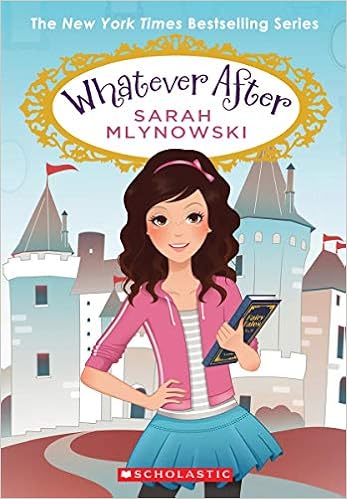
If you watched the show Super Why, you already have a sense of the plots here. In each book, Abby and her brother Jonah are pulled via magic mirror into a fairy tale (think Grimm, Anderson, and Carroll instead of Disney). They disrupt the normal story, and then have to fix it. Or at least get some things back on track. Our daughter loved the first book but petered out in the second one. Abby self-describes as “bossy” (cough internalized misogyny cough) and likes things to go according to plan. Her brother? Not so much. She seems fairly invested in making the romance stories continue on track.
Harry Potter series, J.K. Rowling

You’ve probably heard of these. But while they’re modern classics and required reading for pop culture literacy, it’s worth remembering that they’re also blatant illustrations of male privilege and patriarchy. Hermione is smart, hard-working, and powerful. But she’s the sidekick to an average wizard/jock who is celebrated (and given lots of money) just for showing up. She’s called “bossy,” a pejorative term almost always used to rebuke smart, confident women who try to take charge. Her social justice movement is written as a source of ridicule and scorn. The person she wants to notice her doesn’t see her as a woman until she’s given a Cinderella moment on the stairs of a ball, i.e. when she’s made herself conventionally attractive and objectifiable. If you subscribe to Kate Manne’s notion of misogyny, you could even argue that the book is misogynist towards Hermione. Every significant leader is a male with female subordinates, and most of the major women fall into easy tropes: warm and motherly (Mrs. Weasley, Lily Potter), strict schoolmistress (Professor McGonigal), ethereal unobtainable beauty (Fleur DeLacouer), or spunky hip girl (Tonks). Also note that Rowling says something fairly cringeworthy once or twice a year, which is inevitable for someone of her celebrity (and because you can’t be all things to all people), but she often seems inclined to double down on her statements rather than listen to the community.
Castle Glower series, Jessica Day George
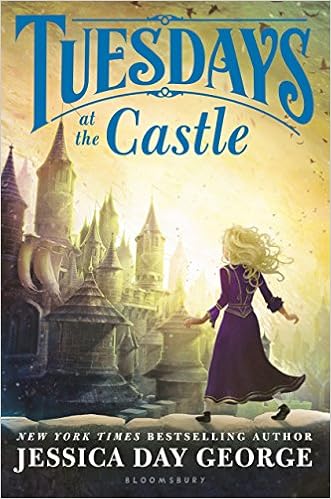
Our daughter devoured this series about a Caucasian girl and her family who live in a magical castle that reshapes itself on a regular basis, usually based on its own thoughts and visions of the future. The book has some intense adventuring, featuring fight scenes and political intrigue. There’s a bit of heterosexual crushing and falling in love here and there, the griffins introduced later in the series are sort of a deus ex machina, the book’s wizards have fairly patriarchal and patronizing views about women, and it’s easy to raise eyebrows at the fact that the Castle never seems to choose a girl as heir to the throne – what are the protagonist’s real options in her future? – but this is overall a fun series with a girl at the center who’s primarily lauded for her intelligence and resourcefulness.
The Enchanted Forest Chronicles, Patricia Wrede

We picked this book up when our daughter first became interested in books without pictures, and it’s a series we’ve all enjoyed since. Princess Cimorene doesn’t like to play by normal princess rules – she finds princesses who do to be insufferable – and so she goes to live with a dragon to save herself from princes. She quickly becomes a valued friend to Kazul and they, along with a variety of magical friends, have a wide range of adventures in and around The Enchanted Forest.
Bliss series, Kathryn Littlewood

I swear that “magical parents who don’t give their kids proper guidance on magic” is a whole subgenre of middle-school books. While this is certainly in that vein, the tension in the situation is well handled, the magic is interesting, and there is appropriate fix-everything silliness. In the first book, Rose is left in charge of the family bakery, which bakes normal treats but also magical ones, while her parents attend to a crisis in a nearby town. As soon as her parents are gone, mysterious “Aunt” Lily appears and puts the kids under a spell until they eventually surrender the treasured magic cookbook. Many hijinks ensue. There’s a bit of girl-on-boy crushing and a whole lot of swooning by townspeople over her older brother’s handsomeness (and relatively little space devoted to the fact that he gets to shirk a lot of work because of the handsomeness). I also don’t know how I feel about the villainous aunt being a woman with ambition compared to the stay-out-of-the-way ethos of the “good” side of the family.
Upside-Down Magic series, Sarah Mlynowski, Lauren Myracle, Emily Jenkins
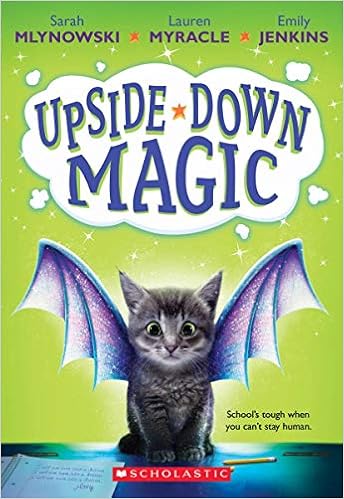
Our daughter devoured this series, falling in love even before she opened the cover with its intensely adorable “dragon kitten” (or dritten.) Nory Horace lives in a world where magic is the norm. But while most people fall easily, predictably, and (one might say) boringly into a few categories with defined skills, Nory is different. Her magic goes “upside-down” or “wonky,” much to the embarrassment of her family. She starts attending an Upside-Down Magic class with other kids (notably of very different skin tones; Nory herself is biracial) whose magic doesn’t do what it’s “supposed” to. It’s pretty clear early on that she and her friends represent really powerful magic, as their teacher (an “Upside-Down” person as well) tries to help them control, understand, and use their unique abilities. It’s very easy to find parallels to neurodiverse students here, and in the first book there are hints that being different has been squashed in the last century of the world’s history.
Love Sugar Magic series, Anna Meriano

We love this series about Leonora Logroño and her family of bruja bakers in small-town Texas. The first book sees Leo learning about the magic running through the women in her family as they all prepare for Dia de Los Muertos, and then misperforming her own magic to wild effect. There’s a bit of sadness, though largely from Leo’s friend, whose mom died from cancer before the book started. Mysteries and tense situations are resolved at a good pace, so young readers don’t get too anxious or lose any threads. Fortunately, the book ends with recipes, because you’ll want to eat something delicious as you read through! (This series will always have a special place; when our daughter switched to independent reading, we had been reading this out loud and she just decided to finish it on her own.)
Saving Winslow, Sharon Breen

In theory, this is a great story for animal lovers: A child in a low-income suburban family nurses a sick donkey to full health until it can return to proper farm life. In practice, I felt like the text had an odd pacing that made it seem dreamlike. Passages of time would go by seemingly randomly. Without a lot of clues, you could be ahead a week or a month. Or maybe the whole book takes place in the span of a few weeks, but with no real context, it’s hard to know. The neighbor girl who becomes a friend is given the barest rationale for her peculiar behavior. And, finally, I don’t feel like you really get to know the titular donkey very well. Louie’s attention to the donkey is a blatant and somewhat heavy-handed counterpoint to the fact that he misses his brother who’s in the military.
